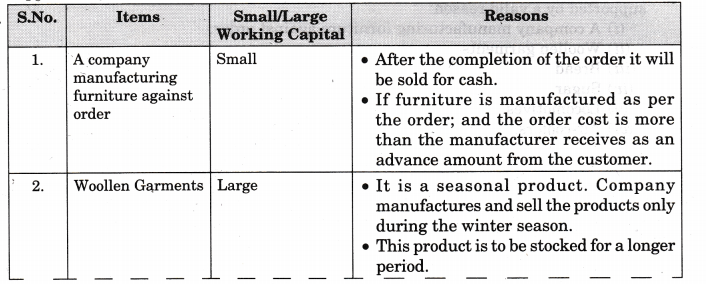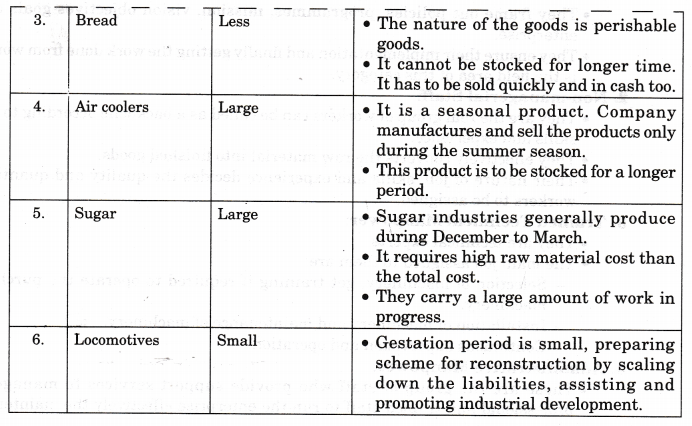NCERT Solutions for Class 11 Entrepreneurship Resource Mobilization
TEXTBOOK QUESTIONS SOLVED.
Question 1. Answer in not more than 15 words:
(i) Define the term ‘resources’.
(ii) Why do entrepreneurs need resources?
(iii) What do you mean by mobilisation of resources’?
(iv) Name two state level organisations, which provide information about the infrastructural facilities.
(v) How can a professional assistance?
Answer: (i) It refers to anything or means physical tangible/non-physical-tangible required or required to support the activities of organisation to achieve pre-determined organizational goals.
(ii) Resources’ are life blood of any economic activity. Resources are needed for setting up and running of the business organisation to achieve the objectives and goals.
(iii) Resource mobilization is the process of getting resource from resource provider like landlord, financiers, labourers using different mechanisms, to implement the organization’s work for achieving the pre-determined organizational goals.
(iv) (i) DIC (District Industries Centre)
(ii) EB (Electricity Board)
(iii) LA (Local Authority)
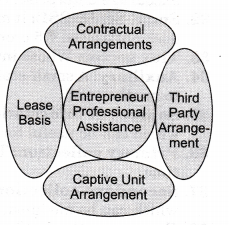
(v) Now-a-days, these services are not limited to licentiates (i.e. individuals holding professionals licenses), they may run to partnership, firms, or corporations as well as to individuals. An entrepreneur procures professional assistance according to analyse and evaluate the extent, nature and type of resource required. He can arrange any one for these types:
- Contractual arrangements
- Third party arrangement
- Captive unit arrangement
- Part time arrangement
- Regular basis
Question 2. Answer in not more than 50 words:
(i) What are physical resources? Give two examples.
(ii) What factors help in determining the resources required?
(iii) What basic resources are required to commence any enterprise?
(iv) Enlist any four expert professional assistance required to start a school.
(v) Name any four factors to be kept in mind while selecting physical resources.
Answer: (i) Physical resources are those that are made by human through his abilities and skills.
They are available to an organisation and it is required for running of an enterprise. For example: buildings, plants, machineries, etc.
(ii) The various factors involved in determining the resources required are:
1. The right type of resource selected by an entrepreneur and other related expert,
2. Procurement should be at right time,
3. All purchases of resources should be at right price with making right use of acquired resources and at last ensuring optimum and fuller utilization of the arranged resources.
(iii) The most basic resources, for any enterprise are:
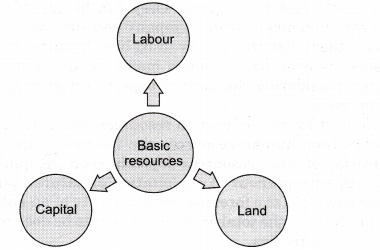
(iv) The main resources used in a school are:
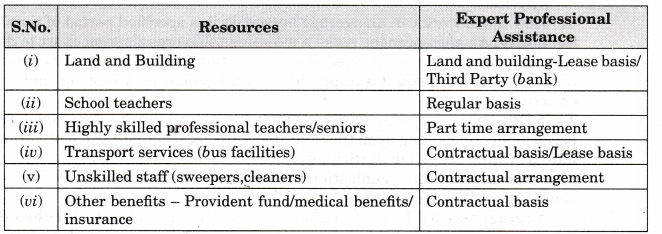
(v) (1) Capital Cost
(2) Access to other resources
(3) Transport and Communication Cost
(4) Availability of manpower and its cost (wages, salaries)
(5) Cost of production
(6) Availability of other utilities like water, gas, fuel, etc.
(7) Access to market for both raw material and finished goods
Question 3. Answer in not more than 75 words:
(i) Why does an entrepreneur need expert professional services?
(ii) What is said to be an “efficient utilization of human resources”?
(iii) Why should entrepreneurs ensure that there is a “right individual at the right job”?
Answer: (i) Today is an era of specialization. Competitive advantage can be realized only when businesses become more efficient in their operations and reduce the cost of their inefficiencies. Give the best to the society.
The need of an expert professional services realized by most of the successful organizations whether small or large in the following form:
(а) Entrepreneurs alone cannot do justice to all areas and aspect of business like – production, distribution, marketing, legal, researching, accounting, human resource or product development, etc.
(b) They do not have ample expertise, resources, time and energy in their hands to meet out the never ending requirements of the enterprise.
(c) Entrepreneurs always work on a strategic plan to accomplish functional goals in an efficient and effective way, they need expert professional services.
(d) In addition to their professional expertise, these are trusted business advisors, experts and connectors. They can be considered as the most important to entrepreneurs growing company and success.
Thus, either outsourcing or availing healthy mix of various professional services from outside the firm, has become a major trend in human resources, and entrepreneur started considering the need of expert professional services as a basic need for an entrepreneur.
(ii) Efficient utilization of human resources means fuller utilization of resources. In an organization, human resources are the most important element and the effective utilization of other resources depends upon the quality of human resources. It also helps an entrepreneur in exploitation of natural, physical, financial resources in a better way. It is the foremost responsibility of an entrepreneur/human resource to:
(a) Finding out the total amount of works to be done and then dividing it into different sets of activities.
(b) The total number of tasks and jobs required to be accomplished under different activities.
(c) How much work can an average person do in a specified period of time? Secondly: An entrepreneur make a manning table/organisation chart to determine: How many people, at what level, in what positions and what kind of experience and training would be required to provide organizational environment and to meet its objectives.
Thirdly: Other ways by which human resources can be developed and led to performance depending upon the total structure, local climate and motivational factor like providing scope for participation, rewards and scope for performance and the futuristic needs of the organisation with the help of all the workforce involved in the operation of the business like:
1. Managerial Staff: Framing policies, objectives goals, etc. for the enterprise, ensuring their implementation and finally getting the work done from workers is the field area of this category.
2. Non-managerial staff: The real group which effectively converts the raw material into finished goods is ‘workers’. Nature of job decides the quality and quantity of workers to be assigned.
3. Trained Technical Manpower: This constitutes of people who have technological expertise and are frequently required for machinery selection, installation, supervision and operation.
4. Administrative Manpower: These are a group of staff which gives support services to managerial, professional and trained staff. They are not involved in production directly but only provide assisting services in the maintenance of the enterprise.
5. Professional Manpower: Chartered accountants, auditors, bankers, lawyers, who are professional experts can be outsourced by the entrepreneur if required. Small enterprises cannot afford them on their regular payrolls.
Thus, efficient utilization of human resources is only possible if the entrepreneur is able to decide:
(a) The total work to be done.
(b) The right type of people who can do the work.
(c) Employing right man at right job.
(iii) Human resource is a vital element for any enterprise and all other resources depends upon the quality of human resources. It also helps an entrepreneur in exploitation of other resources like natural, physical, financial resources in a better way. It includes skilled, unskilled and administrative staff. Growth and development of any enterprises depend on the factors like skills and talents of the employees, competency and talents of the employees, their dedication sincerity and the leadership skills of the owners. Dynamic group or team is always successful in meeting the challenges, changes, problem of the market. A joint effort of all the members of an enterprises contribute to achieve the objectives of an organisation and the feasibility of the enterprises. ‘Right man at right job at the right time’— is the mantra for successful enterprises because it ensures:
(1) Benefits of specialization to the firm
(2) Minimizes wastages of resources
(3) Reduces inefficiencies
(4) Reduces labour turnover ratio and rate of absenteeism
(5) Saves cost of production.
Question 4. Answer in not more than 150 words:
(i) Define ‘intangible resources’. What do they generally comprise of?
(ii) With reference to utilization of resources, state any four moral responsibilities of the entrepreneur.
Answer: (i) These resources are neither felt nor seen, far from being touched or preserved but helps immensely in providing a strong foothold to enterprise.
The intangible possession is a resource which enables a business to continue to earn a profit that is in excess of the normal basic rate of profit earned by other business of similar type. This category generally comprises of:
(a) Goodwill: The difference between the value of the tangible assets of the business and the actual value of the business (what someone would be prepared to pay for it).
(b) Reputation: Though it is generally not present in case of new entrepreneurs. But if he is acquiring or entering into a partnership or some alliance, he may benefit from the goodwill of his associate, if any.
(c) Brands: It is a name given to a product in order to be recognized and differentiated from other similar products.
(d) Intellectual Property: Key commercial rights protected by patents and trademarks may be an important factor to be worked out by the entrepreneur.
(ii) Resource mobilization advocates upon moral responsibilities of the entrepreneur having:
- the right type of resource
- at the right time
- at right price
- with making right use of acquired resources thus ensuring optimum utilization of the same.
Question 5. Answer in not more than 250 words:
(i) What are material resources? While planning state the important decisions to be made by the entrepreneur.
(ii) “Procurement of physical resources is not easy”. Giving reasons, state what is required to be planned for this procurement.
Answer: (i) Whether a business deals in trading business, manufacturing business or a services, certain operations are essentially carried out combining raw material, processing and assembling, machines, tools, power, etc.
Every entrepreneur must have a deep insight into the production processes is essential for effective handling of the enterprise. To successfully convert raw material into finished products with value addition, a wide range of arrangements need to be worked out by entrepreneur. Some of the important decisions are regarding:
(1) Size of the unit and its installed capacity.
(2) Identifying machinery and the technical know-how required.
(3) Technical training involved.
(4) Quality control systems required.
(5) Type of technical staff required.
(6) Maintenance Cost
(7) Availability of spare parts and support services (after sale services)
(8) Wear and tear rate of assets.
(9) The type of raw materials required.
(10) Supplies of the raw material, their number and location.
(ii) Physical resources are those that are made by human through his abilities and skills. It includes various capital equipments required by an entrepreneur at the start up stage of the businesss that he can carried out his business smoothly. They are available to an organisation in the form of:
(a) buildings, plants, machineries, etc.
(b) Raw-material required for the basic operation
(c) Other requirements depending upon the nature of the product and services for running of an enterprise like technology:

• So, the foremost concern for the entrepreneur is to assess the ‘place’ where the enterprise is going to be established.
• The basic infrastructure required to be constructed is all part of physical resources.
• The category of physical resources covers a wide range of operational resources concerned with the physical capability of the enterprise.
A careful selection of physical resources is essential because many allied issues are influenced by the ‘place’, selected, such as:
(1) Capital Cost: with physical resources should be within the limit laid down.
(2) Access to other resources: at initial stage availability should be assured.
(3) Transport and Communication Cost: should be within the limit.
(4) Availability of manpower and its cost: (wages, salaries)-all skilled, unskilled, administrative staff and technical expert should be available and their remuneration should be appropriate.
(5) Cost of production: should not exceed.
(6) Availability of other utilities: like water, gas, fuel, etc. The premises should be located according to the availability of various infrastructural requirement like water, gas, power, fuel, etc.
(7) Access to market: for both raw material and finished goods – within the area easily access and delaying should be avoided for both market and supply of finished goods.
(8) Pollution concerns involved: It should be cross-checked and verified throughout means should not be harmful to society.
Estimating Financial Requirement
Question 1. Answer in not more than 15 words:
(i) Define ‘Capitalisation’.
(ii) Define the term “Business Finance”.
(iii) What is meant by ‘Capital Structure’?
(iv) Name the plan that shows the inflows and utilization of funds.
Answer: (i) “Capitalisation of a corporation comprises the ownership capital and the borrowed capital as represented by long-term indebtness. It may also mean the total accounting value of capital stock surplus in whatever form it may appear and funded long-term debt.”—Lillin Doris.
(ii) Business finance may be defined as the acquisition and utilization of capital funds in meeting the financial needs and overall objectives of a business enterprise.
(iii) It is the composition or mix of different types of long-term capital whether owned or borrowed. It includes all the long term funds consisting of share capital, debentures, bonds, loans and reserves.
(iv) Financial Planning.
Question 2. Answer in not more than 50 words:
(i) Why is finance required for business?
(ii) Enlist the major areas of financial decision-making by the entrepreneur.
(iii) The nature of business affects the requirement of fixed capital. Give two examples to support this observations.
Answer: (i) Finance is the life blood of the business. It is one of the basic foundations of all kinds of economic activities. It is the master key which provides access to all the other sources for being employed in manufacturing and merchandising activities. It is required for many purpose:
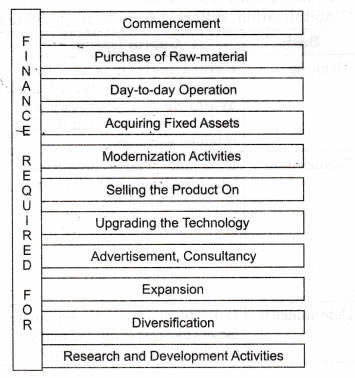
(ii) The two major areas of financial decision-making, requires on part of entrepreneur to take the:
(a) Funds requirement decision
(b) Financing decisions
(iii) • Fixed capital refers to that which is required in a business for meeting the
permanent or long term needs.
• The total capital is divided into two parts -a) Fixed Capital and Working capital. For the business the entrepreneur invest major part of the total capital in the business.
• Need of fixed capital depends upon the nature of business.
• Nature of business is of two kinds: (a) Manufacturing Business, (b) Trading Business and Services.
• In case of manufacturing business, large investment is made in land, building, machinery, etc.
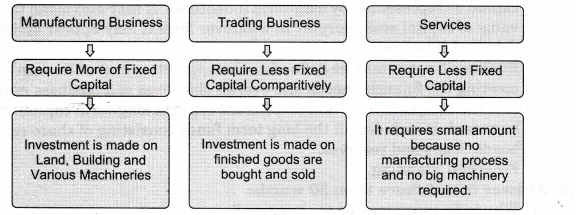
The type or nature of business determines the fixed capital requirement of a concern. Manufacturing concerns require more of fixed capital as they have to invest heavily on purchase of land, plant and machinery building, furniture, other fixed assets according to type of business, etc. Various public utility undertakings like Railways, Electricity, Water supply, other facilities have to invest heavily on fixed assets. Trading organizations does not required heavy investment or it requires very less amount to invest on fixed capital..
Question 3. Answer in not more than 75 words:
(i) How is “Capitalisation” different from “Capital Structure”?
Answer: (i)
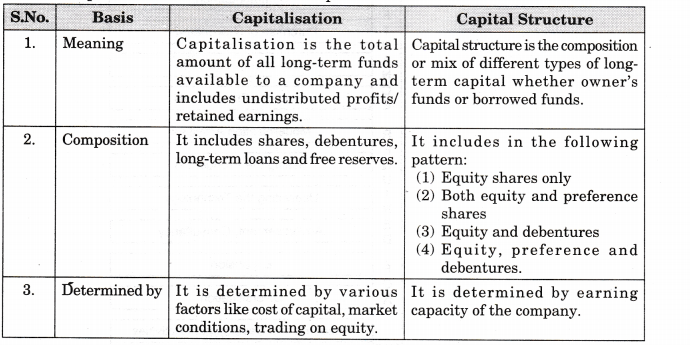
Question 4. Answer in not more than 150 words:
(i) What are the objectives of financial planning?
(ii) Differentiate between the Fixed Capital Requirement and Working Capital Requirement on the following basis:
(a) Meaning and Scope (b) Nature
(c) Duration (d) Sources of Procurement
(iii) State whether the following require small or large working capital. Answer should be supported by a valid reason:
Answer: (i) Financial planning being an intellectual process of formulating a financial plan, is devised to achieve the following objectives:
(а) To assess the amount of finance needed by enterprise.
(b) To assess the different types of financial requirements, viz. long, medium and short-term.
(c) Funds, i.e. capitalization.
(d) To develop suitable capital structure for the enterprise funds from the suitable sources, keeping in view the principles of economy, convenience, financial commitments, ownership, etc.
(e) According to pre-determined objectives, to allocate the funds to various departments according to requirement to achieve the predetermined objectives.
(f) To make the policies related with the finance for the enterprise.
(g) To safeguard the enterprise from financial risk.
(h) To establish effective control on financial matters.
(i) To provide optimum amount of working capital requirement of the enterprise.
(l) To build up reserves for future contingencies.
(ii)
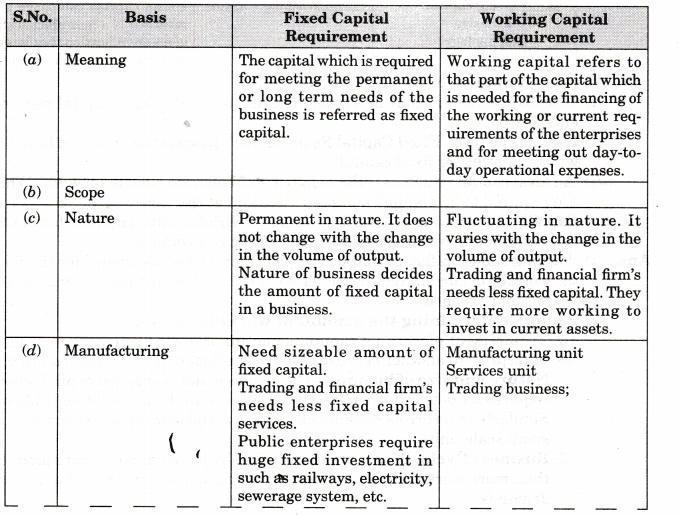

(iii)
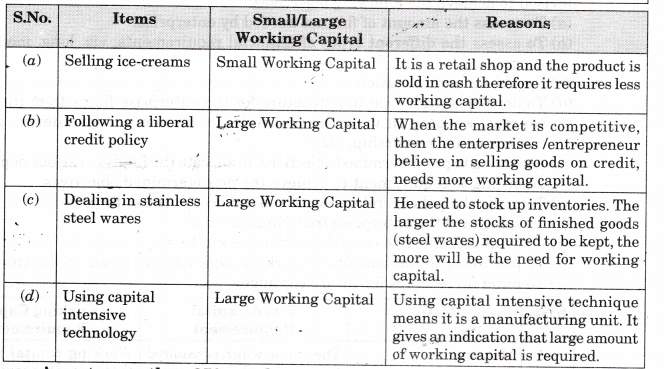
Question 5. Answer in not more than 250 words:
(i) Discuss the factors that determine the amount of working capital required by an enterprise.
(ii) Explain the term ‘Fixed Capital Requirement’. Discuss the factors to be kept in mind while planning for fixed capital.
(iii) ‘An ideal capital structure is the result of great planning and team work’. What factors are required to be planned and paid attention at this time?
(iv) Explain the meaning of “Working Capital”. Briefly state any four factors that help determining the working capital requirement of a company.
Answer: (i) Working capital refers to that part of the capital which is needed for the financing of the working or current requirements of the enterprises and for meeting out day-to-day operational expenses.
Factors determining the amount of working capital:
The requirement of working capital is not uniform in all enterprises. It varies from one enterprise to another because of following factors playing the lead role:
1. Nature and size of business: The business that is engaged in production process requires more working capital in comparison to the one lending trade services.
Similarly enterprises working on large demands for higher working capital than small scale units.
2. Business Cycle: Boom period is marked by more demand, more production and thus more working capital as compared to depression phase having declaimed demands.
3. Gestation Period: Longer the time gap between commencement and end of manufacturing process, more is requirement working capital as compared to industries having shorter gestation period.
4. Volume and procurement of raw material: If amount to be spent on raw material is more in total investment, automatically, the requirement for working capital will be higher as compared to those enterprises where the raw material cost involved is smaller.
5. Manual vis Automation: In labour intensive industries, large working capital will be required than in the highly mechanized ones.
6. Need to stock up inventories: The larger the stocks of whether raw material or finished goods required to be kept, more will be the need for working capital and vice-versa.
7. Turnover of working capital: Turnover means the rate at which the working capital is recovered by the sale of finished goods enterprises where the rate is higher-less working capital is required as compared to enterprises having lesser slow rate.
8. Terms of Credit: Those enterprises who believe in selling goods on credit, needs more working capital than the ones selling goods against cash.
(ii) The capital which is required for meeting the permanent or long term needs of the business is referred as fixed capital. It is that part of the total capital of an enterprise which is invested for the purchase of fixed assets like land and building, plant and machinery, etc.
Features:
Fixed capital’exhibits the following characteristics:
(a) It is not easy to withdraw the capital from business, as it’s more like a permanent capital.
(b) Generally the fixed capital is procured through long term financial resources.
(c) It is invested in procuring fixed assets.
(d) It forms the basis for income generation capacity of the enterprise.
The assessment of fixed capital requirement for a business can be made by preparing a list of fixed assets required. At the same time, an entrepreneur should keep in mind the following factors too:
(а) Nature of his/her business: viz. trading, manufacturing, services.
(b) Size of the business: small business needs less fixed capital in comparison to
large scale enterprises. .
(c) Technology to be used in production, i.e. whether capital intensive or labour intensive.
(d) Range of production: If more diversified products are manufactured, more is
fixed capital requirement in comparison to those who deal in single type of product range. . ‘
(e) Type of product to be manufactured: It may range from being simple (e.g. soap) to a highly complicated machinery, thus demanding more investment in fixed assets.
(f) Method of acquisition of fixed assets: The option of buying a fixed asset demands more capital in comparison to acquiring an asset on lease or hire purchase system.
(iii) Following factors affect the determination of capital structure:
(a) Nature of sales: Higher is the sale of the product, greater is the turnover and consequently the fixed obligations are difficult to for fulfilling. Here the enterprise has to rely on obtaining more debt. In case the sales are low, debt is not preferred.
(b) Control: If the enterprise is willing to share the power then equity is preferred, If it does not want to dilute its control then it prefers debt, debentures etc.
(c) Flexibility: Capital structure should be flexible enough to raise additional funds without undue delay and cost.
(d) Legal factor: A enterprise has to work within the framework of the law. It has to modify and make changes with the changing laws of the country. The rules for this purpose are made by SEBI, Govt, of India, etc.
(e) Situation of market: During the period of boom, the trust is more on equity shares thus it is preferable. During the situation of depression, the trust is on debentures and also debt is not preferable.
(iv) Working capital refers to that part of the capital which is needed for the financing of the working or current requirements of the enterprises and for meeting out day-to-day operational expenses.
Factors determining the amount of working capital:
The requirement of working capital is not uniform in all enterprises. It varies from one enterprise to another because of following factors playing the lead role:
(a) Size of business: The business that is engaged in production process requires more working capital in comparison to the one lending trade services.
Larger is the size of enterprise, larger is the requirement of working capital. On the contrary, smaller is the size of enterprise, smaller is the requirement of working capital.
(b) Business Cycle: Boom period is marked by more demand, more production and thus more working capital as compared to depression phase having declaimed demands.
(c) Gestation Period: It refers to the time gap between commencement and end of manufacturing process. Longer is the length of operating cycle/gestation period larger is the requirement of working capital because it is due to the fact that more money is needed for making stocks, purchasing raw materials, etc. and if shorter the period less working capital is required.
(d) Volume and procurement of raw material: If amount to be spent on raw material is more in total investment, automatically, the requirement for working capital will be higher as compared to those enterprises where the raw material cost involved is smaller.
(e) Manual vis automation: In labour-intensive industries, large working capital will be required than in the highly mechanized ones.
(f) Need to stock up inventories: The larger the stocks of whether raw material or finished goods required to be kept, more will be the need for working capital and vice-versa.
(g) Turnover of working capital: Turnover means the rate at which the working capital is recovered by the sale of finished goods enterprises. Higher is the sales turnover, lower is the requirement of working capital. The revenue obtained from the current assets. On the other hand, lower is the sales turnover; higher is the requirement of working capital.
(h) Terms of Credit: Those enterprises who believe in selling goods on credit, needs more working capital than the ones selling goods against cash.
(i) Nature of the enterprise: Requirement of working capital is different types of enterprises. Restaurants, hotels, etc. have less working capital requirement due to cash sales. Enterprise producing heavy machines needs more working capital, as their operating cycle is longer.
Sources of Finance
Question 1. Answer in not more than 15 words:
(i) What is public financing?
(ii) Define debentures as a source of finance.
(iii) Why is equity share capital called “Risk Capital”?
(iv) From which type of capital are raw-materials purchased?
Answer: (i) It is a process of arranging finance from public by an entrepreneur. It is usually raised through shares and debentures.
(ii) Debenture is a formal document issued by an enterprise containing acknowledgement of debt. It normally have set terms and conditions. These conditions may be regarding payment of interest, time period of repayment, mode of repayment etc. According to Section 2 (12) of Indian Companies Act, 1956 debenture includes debenture stock, bonds and any other securities of the company whether constituting a charge on the company’s assets or not.
(iii) Equity shareholders are the virtual owners of the company. Thus, company is under no obligation to pay them either the principal amount or dividend and that’s make them true risk bearers. For start-up entrepreneur, accessing equity capital may be a difficult task as risk involved for investor is high.
(iv) It is working capital because working capital is a short-term capital.
Question 2. Answer in not more than 50 words:
(i) On the basis of duration, classify the sources of finance.
(ii) What are the major sources of capital of a Public Limited Company?
(iii) In terms of tax benefits, which one of the two-preference shares or debentures will be preferred by the organization? Give reasons.
Answer: (i) Sources of finances can be classified on the basis of duration:
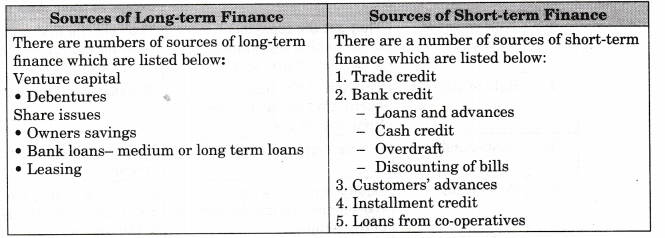
(ii) Equity.
(iii) Debentures will be preferred.
Reason: The interest paid on the borrowed fund is tax deductible, i.e. no tax is to be paid the entrepreneur on interest.
Question 3. Answer in not more than 75 words:
(i) Define ‘personal financing’. Give its sources.
(ii) Differentiate between ‘equity shares’ and ‘preference shares’.
(iii) Differentiate between ‘owner’s funds’ and ‘borrowed funds’.
Answer: (i) The entrepreneur always makes the initial investment capital available. Either he invests his personal cash or converts his assets into cash for investment. Generally, the entrepreneur very often mobilizes his personal resources for enterprise development using his private assets or from his members of the family, dear and the near ones.
The investors from the family may not have a legal hold on the enterprise. They tend
to remain as silent partners extending informal assistance.
Sources
(a) Personal Savings: Past savings, if any, is the most conventional source of financing, dependable, readily available and without incurring any liability. This accumulated form of minor or major savings done by entrepreneur is an internal source and meets out small, short term requirements.
(b) Friends and Relatives: Arranging finance from near and dear ones viz. (a) friends
(b) relatives (c) known persons, in informal manner is even a popular source of financing.
(c) Chit Funds: This customary source where in some members who might be friends, or known, etc. form a type of club, committee, party, association, etc. keep paying monthly deposits privately and can claim the ‘chit’ if his sudden demand for money i.e. like ‘kitty’. This premature encashing of the deposited amount is like an internal source of financing and personal.
(d) Deposits from Dealers: When the dealers or distributors are appointed by the business firm, the dealers selected are required to give security deposits to the entrepreneurs, depending upon the reputation, goodwill and creditability of the enterprise. This can be used as a short term source of financing.
(ii)
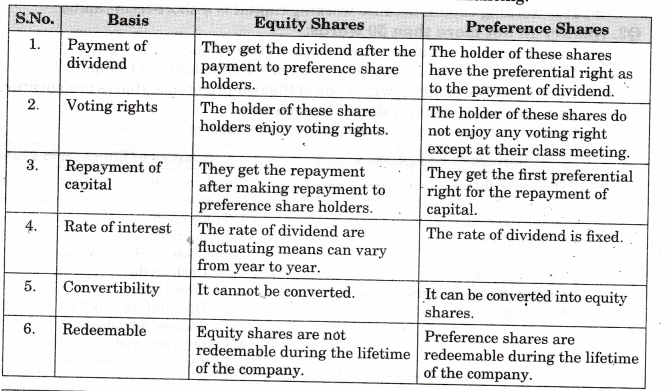
(iii)
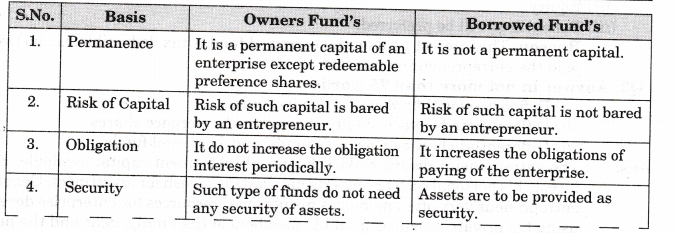

Question 4. Answer in not more than 150 words:
(i) Public deposits are a good source of raising medium term finance. How?
(ii) When is it appropriate to use financial institutions as a source of financing?
(iii) Name the following:
(a) The persons who are given preference in payment of dividend and repayment of capital.
(b) The person who are owners of a company.
(c) The secured creditors of a company.
(d) The source of finance in which the right to use assets for a specific period is worked out.
Answer: (i) Public deposits are a good source of raising medium term finance
(a) It is source of investment through the general public and public are supposed to deposit their savings with his company.
(b) The company at the time of accepting the amount of deposit immediately issues a receipt mentioning the amount of loan, rate of interest and date of repayment.
(c) The deposit period should not exceeding 36 months.
(d) The existing shareholders or any employees of the company can deposit the money.
(e) The depositor will get the principal amount and the rate of return (interest).
(f) The rate of interest is generally higher than the rate applicable on bank deposits.
(g) The depositors have no rights and control over the management, and
(j) The company does-not give any guarantee of paying back of interest and loan amount.
(i) They are like unsecured creditors of the company.
(j) The deposit amount of depositer with the company are not insured with the insurance company.
(ii) Financing an enterprise-whether large or small-is a critical element for success . in business. Financing is the use and manipulation of money. Raising money for a business is one aspect of financing. All new entrepreneurs most of the time face difficult problems to arrange startup finance.
While finance is a life blood of the business and is needed throughout the life of business, the new entrepreneur faces significant difficulties in acquiring capital at start-up.
(a) The entrepreneur needs to consider all possible sources of capital and select the one that will provide the needed funds at minimal.
(b) Different sources of funds are used at various st ages in the growth and development of the venture.
(c) If an entrepreneur cannot personally supply the necessary amount of money, other option is ‘OTHER PEOPLE’S MONEY (OPM)’. It means, before seeking outside financing; an entrepreneur should first explore all methods of internal financing and the other external financing and if it suits an entrepreneur he can go for use financial institutions as a sources of financing.
(d) Financial institutions provide services as intermediaries of financial markets. There are three major types of financial institutions.
(i) Depository institutions (ii) Contractual instutions
(iii) Investment institutions
(e) Sources of finance to industry, other than commercial banks. These institutions are established by the Central/State Government, aiming at:
(a) Promoting the industrial development of a country.
(b) Providing both owned capital and land capital for long and medium term requirements.
(c) Supplement the traditional financial agencies like commercial banks.
(d) To encourage setting up of industries in backward areas.
(e) To provide technical assistance to industrial units.
(f) To develop investment markets.
(iii) (a) Preference shares (b) Sharesholders
(c) Debentures (d) Term loan.
Question 5. Answer in not more than 250 words:
(i) What is ‘venture capital’? Explain the mode of raising funds.
(ii) Discuss the various sources of financing capital through ownership.
(iii) Explain the term ‘debt financing’. How are Banks an important source of debt financing?
Answer: (i) The term venture capital is defined as a equity by which an investor supports an
entrepreneur talent with finance and business skills to exploit market opportunities and thus obtain a long term market gains. These are investors and investment companies whose specialty is financing new, high potential, high-technology oriented entrepreneurial ventures.
The mode of raising finds through venture capitalists :
(a) They are more interested in financing ventures which are in their second or third stage of development.
(b) They often provide initial equity investment to start up a business.
(c) Such ventures can be of software, biotechnology, high-potential ventures, high- technology ventures or are venture having high potential prospects and returns expected.
(d) Venture capitalists look for a high rate of return. Thus, they want equity, or some share of ownership in return for their capital.
(e) They are willing to take the higher risk of losing their capital for a chance of profit from the business’s success.
(f) The venture capitalist sells his or her percentage of the business to either another investor or back to the entrepreneur after specific number of years association or when he finds returns lowering down.
(g) Mostly small business approach to venture capitalists when they want to start or grow a business but couldn’t persuade banks to lend money.
(h) These investors have a deep insight about the fields in which they make their investment, but they behave like more or less as non-working partners do not interfere in the management of the enterprise but protect them at initial stage by keeping good contact with them.
(i) Venture capitalist more careful while investing in any venture as they know that investment is highly liquid. It means it is not subject to repayment on demand.
(ii) On the basis of ownership, finance may be classified into two categories:

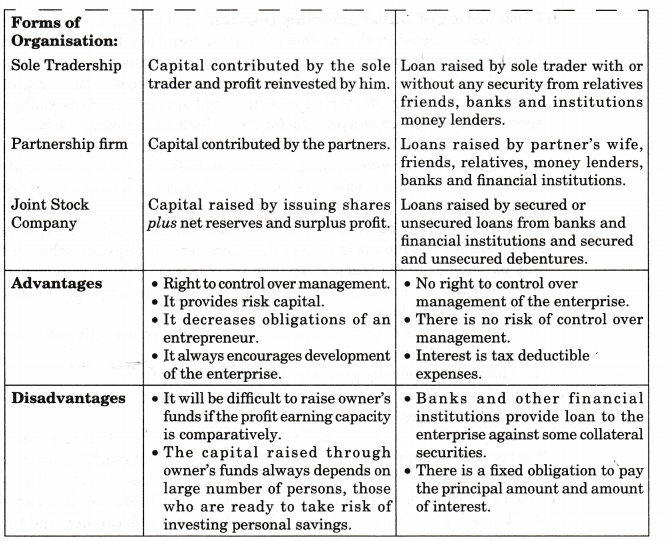
(iii) Debt-financing is a financing method involving an interest-bearing instruments, usually a loan, the payment of which is only indirectly related to the sales and profits of the venture. Typically, debt financing called as asset-based financing requires that some asset, e.g. car, house, etc. be used as a collateral. Here, the entrepreneur is to pay back the amount of funds borrowed and the amount of interest.
Commercial banks, generally extends short term to medium term loans to firms of all sizes and in many ways like:
(a) Overdraft: A temporary arrangement in the form of a permission granted to the customers to withdraw more than the amount standing to his/her credit.
How it works:
1. Under overdraft, the bank permits the customer to overdraw his account up to a certain limit for an agreed period.
2. To avail of this facility, a customer should have a current account with that bank.
3. Interest is charged on the amount actually overdrawn.
4. Overdraft may be allowed on the security of assets or customer’s personal security.
(b) Cash Credit: This facility is like overdraft arrangement with its features being:
1. The bank allows the borrower to borrow up to a specified limit.
2. The amount is credited to the account of the borrower.
3. The customer can withdraw this amount as and when he requires.
4. Interest is charged on the amount actually withdrawn.
5. Cash credit is usually granted on a bond or some other security.
(c) Discounting of Bills/Factoring: Discounting of bills, is an arrangement, where in the bank encashes the customer’s bills before they become due for payment. For this, the bank charges a nominal amount called discounting charges. In case the bill is dishonoured on due date, the bank can recover the amount from the customer. Similarly, factoring is a financial service which is rendered by the specialized person known as a ‘factor’, who deals in realizing the book debts, bills receivables, managing sundry debtors and sales registers of the commercial and trading firms in the capacity of agent for a commission called commercial charges or discount, Thus, it is the sale of accounts receivables to a bank or finance company or anyone else.
(d) Loans and Advances: A loan is a lump sum advance made for a specified period. Here, the entire amount is paid to the borrower in lumpsum either in cash or by way of transfer to his account. In this:
1. The borrower may withdraw the entire amount in a lumpsum or in installments as per his/her needs.
2. The interest is charged on full amount of loan irrespective of how much had been actually withdrawn.
3. Loans are generally granted against the security.
(f) Term Loan: These loans are extended by the banks to their customers for fixed period to purchase:
1. Machinery 2. Trucks, scooters 3. Houses, etc.
The borrower repays these back in monthly/quarterly/half yearly/annual installments.
(g) Demand Loans: These loans are provided by the banks against the security of Fixed Deposits Receipts (FDR), Government Securities, Life Insurance Policies, etc. These loans are called demand loans because bank can demand them at any time, by giving notice to the customer.
Mentor Ship
Question 1. Answer in not more than 15 words:
(i) Who is a ‘Mentor’?
(ii) Define the term ‘Business Mentor’.
(iii) Give one difference between Group Mentoring and Peer Mentoring.
Answer: (i) A mentor is an experienced person, trusted guide, an advisor, wise and intellectual person who provides information, support, and encouragement, uses the mind creatively especially to another person, in their board for day-to-day issues encountered on the job and alternative perspectives on issues in terms of both problem identification and problem solving.
(ii) Business refers to an established person who is capable and willing to offer invaluable advice, support and guidance to a new entrepreneur is referred as Business mentor.
(iii) Group Mentoring/Peer Mentoring: This requires a mentor to work with 4-6 mentees at one time. Mentoring relations, formally or informally with colleagues.
Question 2. Answer in not more than 50 words:
(i) What is informal mentoring?
(ii) Enumerate the role played by the mentor.
Answer: (i) (a) There is no mentoring agreement.
(b) Goals of the relationship are not specified.
(c) Outcomes are not measured.
(d) Mentor and mentee self-select on the basis of personal chemistry.
(ii) (a) Help in diagnosing in order to define and understand the current situations in ,’ the enterprise.
(b) Help a mentee to assess his/her areas of shortcomings and strengths, giving critical , feedback to him in key areas.
(c) Provide assistance in finding the necessary information.
(d) Provide assistance in preparation of documentation for the enterprise and enterprise support programmes.
(e) Provides guidance and support in preparation and implementation of development activities/plans/projects, in order to achieve the best possible business results.
(f) Helps in identification, procurement and utilization of resources required for the proposed venture.
(g) Provides assistance in finding business partners.
(h) Provides consultation, and helps in coordinating activities aimed at accessing funds, new technologies, etc.
(i) Introduce the mentee to relevant consultants, trainers, suppliers, lawyers, accountants, etc. for that will help him boost confidence.
(l) As the mentor has the experience of witnessing ‘highs’ and ‘lows’ daring his venture starting, he/she can be a great source of introducing mentee to threats, can risks of market. –
(k) Helps the mentee in learning, specific skills, knowledge, unspoken rules critical for success of business. Mentoring benefits the enterprise, mentors and mentees.
Question 3. Answer in not more than 75 words:
(i) What benefits do mentors gain from their function?
(ii) Explain the concept of mentoring. Give two examples to support your answer.
Answer: (i) Mentors enjoy many benefits:
(a) Gains insights from the mentee’s background and history that can be used in the mentor’s professional and personal development.
(b) Gains satisfaction in sharing expertise with others.
(c) Re-energizes the mentor’s career.
(d) Gains an ally in promoting the organization’s well-being.
(e) Learns more about other areas within the organization.
(ii) Mentoring is about a person helping another to achieve something beneficial.
He is a faithful, wise advisor, creates an informal environment, in which the other person feels encouraged to discuss their needs and circumstances openly and in confidence.
Mentoring is a powerful personal development and empowerment tool.
His help and support are in a non-threatening manner, so that the recipient appreciates and give values to him.
It involves to support and encourage people to manage their own learning in order that may maximize their potential develop their skills, improve performance and become the person they want to do.
Examples:
1. Family members, experienced friends or your career advisor giving out advice.
2. Well established person who is capable and willing to offer invaluable advice, support and guidance to a new entrepreneur.
3. Teacher teaches students.
4. Group of promoters advising and new entrepreneurs.
5. Coaching is also one of the transactional situation.
Question 4. Answer in not more than 150 words:
(i) Briefly state the different types of mentoring.
(ii) “Not only the entrepreneur but also the entire organization benefits from Mentoring”. Explain?
Answer: (i)
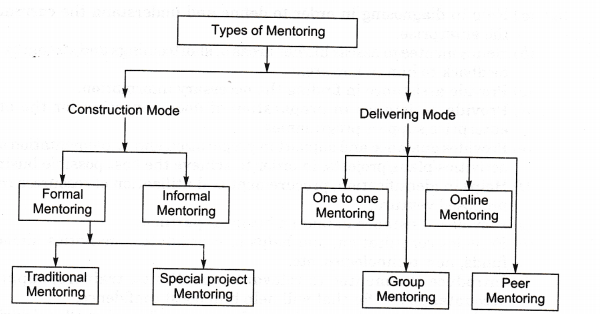
Types:
Generally, a mentor does not get involved in the daily activities of the business. But they will stay in contact with the new business owner, and make themselves available when questions arise.
At the start, the person being mentored may need more frequent meetings but as the mentee grows confident, they will need fewer contacts with the mentor. It is for the mentee to select the type of mentoring required.
Mentoring thus may be classified on two grounds:
(a) Mode of construction (in which way mentorship is structured)
(b) Mode of delivering (in which manner mentorship is rendered).
Informal:
• Goals of the relationship are not specified
• Outcomes are not measured
• Mentor and mentee self-select on the basis of personal chemistry.
Formal:
• Mentor and mentee are paired based on compatibility
• Goals are established from the beginning by the organization
• Outcomes are measured.
Delivering Mode
One-on-one: This mentoring matches one mentor with one mentee.
Group Mentoring: This requires a mentor to work with 4-6 mentees at one time. Online Mentoring: Mentoring relations through computerized programmes.
Peer Mentoring: Mentoring relations, formally or informally with colleagues.
(ii) Mentoring in itself benefits the organisation through:
• Enhancing strategic business initiatives.
• Encouraging retention.
• Reducing turnover costs.
• Improving productivity and production.
• Breaking down the “silo” mentality by senior employees and in between employers and employees.
• Elevating knowledge transfer from just getting information and to retaining the practical experience and wisdom gained from long-term employees.
• Enhancing professional development.
• Linking employees with valuable knowledge and information to other employees in need of such information.
• Using own employees, instead of outside consultants, as internal experts for professional.
• Development and encouraging them.
• Supporting the creation or a multicultural workforce by creating relationships among diverse employees and allowing equal access to mentoring.
• Creating a mentoring culture, which continuously promotes individual employee growth and development.
Question 5. Answer in not more than 250 words:
(i) Discuss the role and importance of mentoring.
(ii) Explain mentoring. What are the characteristics?
Answer: (i) For giving a strong foothold to the venture and ensuring its growth, the role of the mentor is very wide, crucial and significant. This long-term guidance support, enabling someone who is less experienced to develop and grow in their chosen role can be summarized as follows:
(а) Help in diagnosing in order to define and understand the current situations in the enterprise.
(b) Help a mentee to assess his/her areas of shortcomings and strengths, giving critical feedback to him in key areas.
(c) Provide assistance in finding the necessary information.
(d) Provide assistance in preparation of documentation for the enterprise and enterprise support programmes.
(e) Provides guidance and support in preparation and implementation of development activities/plans/projects, in order to achieve the best possible business results.
(f) Helps in identification, procurement and utilization of resources required for the proposed venture.
(g) Provides assistance in finding business partners.
(h) Provides consultation, and help in coordinating activities aimed at accessing funds, new technologies, etc.
(i) Introduce the mentee to relevant consultants, trainers, suppliers, lawyers, accountants etc. for that will help him boost confidence.
(j) As the mentor has the experience of witnessing “highs’ and ‘lows’ during his venture starting, he/she can be a great source of introducing mentee to threats, risks of market.
(k) Helps mentee in learning, specific skills, knowledge, unspoken rules critical for success of business.
(ii) Mentoring is about a person helping another to achieve something. As a faithful and wise advisor he creates an informal environment, in which the other person feels encouraged to discuss their needs and circumstances openly and in confidence.
It is a powerful personal development and empowerment tool. He/she is always providing help and support in a non-threatening way, in a manner that the recipient appreciates and values is mentoring. It involves to support and encourage people to manage their own learning in order that may maximize their potential, develop their skills, improve performance and become the person they want to do.
It is the process through which someone who is perceived as a facilitator, listener, coalition builder, trustworthy, creates a safe learning environment, without making the mentee worry about negative consequences.
These are the following characteristics of mentoring :
1. Takes place outside a line manager-employee relationship, at the mutual consent of a mentor and the person being mentored.
2. It always focuses on professional development and sometimes may go beyond the extent like outside a mentee’s area of work.
3. It is always considered as a personal relationship. As a mentor he provides both professional and personal support.
4. Relationship may be initiated by a mentor through a match initiated by the organization.
5. Relationship crosses job boundaries.
6. Relationship may last for a specific period like short period of time (nine months to a year) in a formal program, at which point the pair may continue in an informal mentoring relationship.
7. It is really about developing a person’s character and ability to grow. Coaching is more for the immediate future.
8. The relationship itself, which determines if the mentoring will be successful. Trust, rapport and caring are important in coaching but the relationship dynamic is not the same.
9. Mentoring is a gift, and usually the person will pay it back by mentoring someone else. This is what helps mentoring grow exponentially throughout society. Coaching is a more transactional situation.
Sources of Information
Question 1. Answer in not more than 15 words:
(i) Define Census Method of collecting data.
(ii) Name the main producers of information.
(iii) Name the-sources available to an entrepreneur at the state and the central level, to seek information regarding plant and machinery .
Answer: (i) It refers to the method of collecting data covering each and every item of the prescribed area under investigation.
(ii) There are three main producers/originators of information. These are the:
(a) Government Agencies (b) Academic Institutions
(c) Private sector (d) Individuals
(iii) SFC (State Finance Corporation).
CCIE (chief Controller of Import and Export).
Question 2. Answer in not more than 75 words:
(i) Identify any six major small scale industry groups in India.
(ii) What purpose does ‘information’ serve for an entrepreneur?
Answer: (i) Small scale industries: These are the industrial units whose investment in plant and machinery does not exceed ? 5 crore.
The main features of these industries are as follows:
(i) Labours are the main people involved in the part of production. They will be get wages.
(ii) They use machine and runs with electricity.
Examples:
(a) Hosiery factories in Ludhiana.
(b) Scientific instruments making factories in Ambala.
(c) Carpet making factories in Panipat.
(d) Radio, TV, etc. manufacturing factories in Delhi.
1. Tiny Sector: Only the business enterprises which are constituted under the tiny sector and whose investment in plant and machinery is up to 25 lakhs, but would
• shortly be raised irrespective of location of the unit.
2. Auxiliary Small Units: A small-scale industry unit can be known as ancillary (auxiliary) small industrial unit if it supplies not less than 50% of its production to another unit, referred to as the parent unit. Such type of units manufacture tools and equipments, components, unfinished goods, spare parts, etc. for the parent units.
These units also enjoy the benefit of getting demand from the parent units so that they can survive for long time and time to time they get financial help also from their parent unit.
3. Micro-business: A unit can be called as micro business enterprise, if it has an investment in plant and machinery and it does not exceed 25 lakh.
4. Small-scale Service and Business (industry Related) Enterprise:
The definition of MSME’s (Ministry of Micro, Small and Medium Enterprises) in the service sector is:
Micro-enterprise: Investment in equipment does not exceed 10 lakh.
Small enterprise: Investment in equipment is more than 10 lakh but does not exceed 2 crores.
Medium enterprise: Investment in equipment is more than 2 crores and less than 5 crores.
5. Small-Scale Industries Owned and Managed by Women Entrepreneurs:
A small-scale industry can be known as a ‘Women Enterprise’ if a woman or a group of women individually or jointly, have share capital of not less than 51%. Such type of enterprises can avail of the concession offered by the government, e.g. low rate of interest on loans, etc.
6. Export-oriented: A small scale industry unit can be known as export-oriented unit if it exports more than 50% of its production. Such type of units have the benefit like subsidy offered by the government.
The Ministry of MSME & ARI will bring out a specific list of hi-tech and export oriented industries which would require the investment limit to be raised upto 5 crores to admit of suitable technology upgradation and to enable them to maintain their competitive edge.
7. Cottage and Rural: According to the Fiscal Commission, “Cottage industry is an industry which is run either as whole-time or part-time occupation with the full or partial help of the members of the family.”
The main features of these industries are as follows:
(i) Run only by the members of the family.
(ii) Mainly run by the artisans at their homes.
(iii) Involve very little capital.
(iv) Often fulfil the requirement of a local region.
(v) Involve rare use of machines.
(vi) The main examples are khadi and handicrafts industries. Traditional items are manufactured in these industries like mats, shoes, pottery, etc.
(ii) Importance of Information for an Entrepreneur:
Entrepreneur is a person who conceives an idea, or who discovers the opportunity in the environment. This ability of an entrepreneur of perceiving and sensing an opportunity, makes him always, search “For knowledge/need/problem” in the environment. He needs to, in depth scan “inquiry/idea”/“quest” so as to evaluate its feasibility and viability. A detailed investigation is a must, before an entrepreneur converts the idea into enterprise. The most common parameters to be investigated are:
(1) Feasibility, viability, application and utility of prevailing market conditions viz. demand, supply, competitors.
(2) Types of resources required and their supplies.
(3) Expected profitability.
(4) Prevailing environmental factors and their impact on idea’s feasibility. Thus, before any decision is taken an entrepreneur needs accurate, authentic and relevant information.
Question 3. Answer in not more than 150 words:
Identify the information resource centre at the State and Central levels available in India to the entrepreneur regarding:
(a) Product standardization and quality mark.
(b) Technical know-how.
(c) Selection of project.
(d) Registration.
Answer:

Question 4. Answer in not more than 250 words:
(i) Differentiate between Primary, Secondary and Tertiary source of information.
(ii) What is meant by primary source of information? Explain the method of collecting primary data.
Answer: (i)
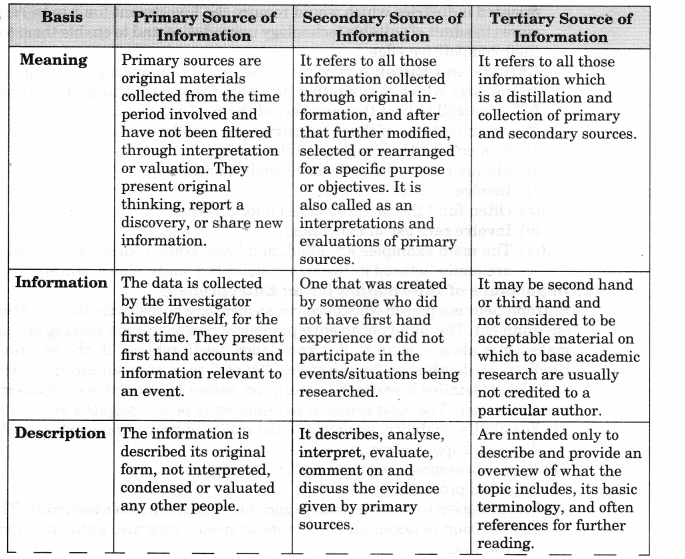
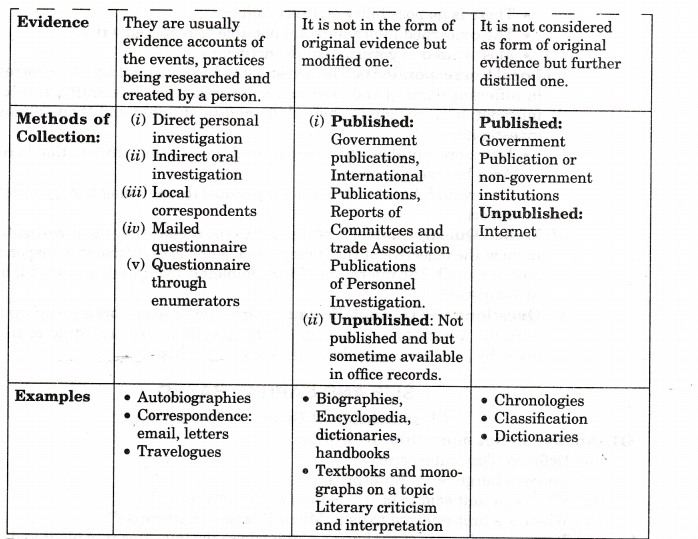
(ii) Primary sources are original materials and collected from the time period involvec and have not been filtered through interpretation or valuation. They present original thinking, report a discovery, or share new information and it is based on in-depth research studies.
It includes:
(a) The data is collected by the investigator for the first time.
(b) Primary source report, a discovery or share new information.
(c) They present first hand accounts and information relevant to an event.
(d) They present information in its original form, not interpreted, condensed or evaluated by other writers.
(e) They are usually evidence or accounts of the events, practices being researched and created by a person who directly experienced that event.
(f) Primary sources are the first formal appearance of results in print or electronic formats.
Methods of Collection:
The different methods of collecting data are as follows:
(a) Direct Personal Investigation: It refers to the method by which the investigator collects the information personally from the informants and the source concerned. It can be possible if field of investigation is limited. More degree of originality and accuracy is required. Direct data with the informants are required.
(b) Indirect Oral Investigation: The investigator collects the information not from the original person but approaches certain sources which are close or to be known directly or indirectly to the informants.
- It can be more suitable-if the field of investigation is large.
- There is no possibility of direct contact.
- The concerned informants are not able to read and write.
- Mostly used in government departments.
(c) Local Correspondents: The investigator appoints local agents or correspondents in different parts of the area under investigation. Generally, they collect the information according to their skills and tactfulness and then submit it to the investigators.
- It is more suitable when regular and time-to-time information is required.
- Area has wide coverage.
- The availability of information is possible through magazine, journals, annual report.
(d) Mailed Questionnaire: It refers to the type prepared by the investigator keeping in view the objective of the inquiry and sends it to informants/respondents who post or e-mail. The informants fill it completely by himself and send it back to the investigator.
(e) Questionnaire through Enumerators: The enumerators go to informants along with the questionnaire to help fill the questionnaire according to the answers given by the informants. It is also known as schedules.
Size and Capital Based
Classification of Business Enterprises
Question 1. Answer in not more than 15 words:
(i) Define a ‘Tiny enterprise’.
(ii) Define a Large Scale Enterprise.
(iii) When is a unit said to be a “Medium Scale Enterprise”?
(iv) When is a unit referred to as a “Micro-Business Enterprise”?
Answer: (i) Tiny enterprises are those business unit where the investment in plant and machinery does not exceed Rs 2.5 million (Rs 25 Lakhs) irrespective of the location of the unit.
(ii) The industrial units whose investment in plant and machinery exceeds 10 crores are
said to be large units. .
(iii) A medium enterprise is one where the investment in plant and machinery is more than ? 5 crore but does not exceed ? 10 crore.
(iv) A unit is known as micro business enterprise if it has an investment in plant and machinery (their original cost excluding/and building and items specified by Ministry of SSI in its notification No. S.O. 1722 (e) dated Oct. 5, 2006) does not exceed Rs. 25 lakh.
Question 2. Answer in not more than 50 words:
(i) List the parameters used to measure the volume of the business.
(ii) How would you differentiate between an ancillary unit and a tiny unit?
(iii) When is any activity referred as a ‘Business Activity’?
Answer: (i) Following are the list of the parameters used to measure the volume of the business.
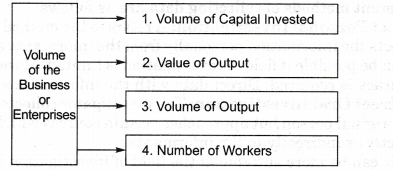
(ii) Differences between an ancillary unit and a tiny unit.
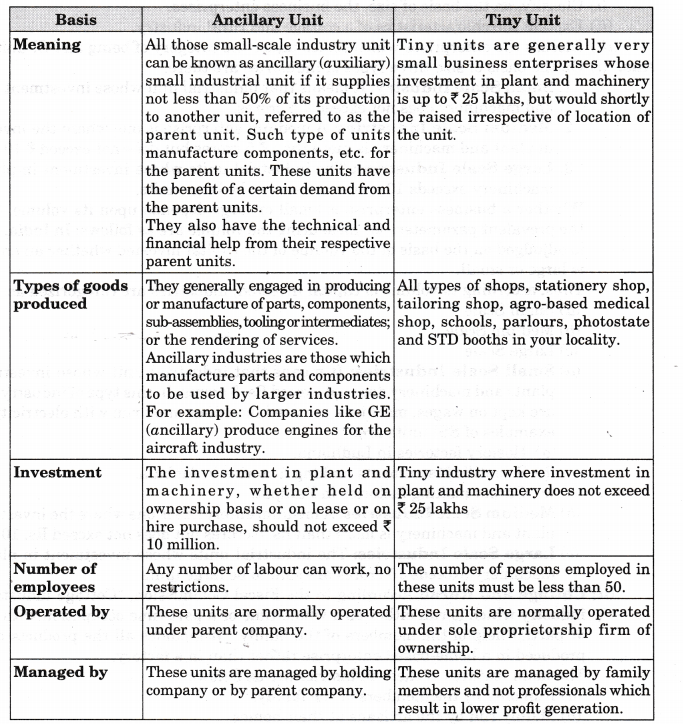
(iii) All the activities which are undertaken in connection with the place of production to the place of consumption is said to be business activity.

Question 3. Answer in not more than 75 words:
(i) Classify, on the basis of size, the business enterprises.
(ii) Explain the characteristics of a cottage and rural industry.
(iii) Discuss the enterprises which comes under the category of being an SSI units.
Answer: (i) On the basis of size three types of industries are there:
1. Small Scale Industry: It means that industrial unit whose investment in plant and machinery does not exceed Rs 5 crores.
2. Medium Scale Industries: A medium enterprise is one where the investment in plant and machinery is more than Rs 5 crores but does not exceed ? 10 crores.
3. Large Scale Industries: The industrial units whose investment in plant and machinery exceeds 10 crores are said to be large units.
Whether a business enterprise is small or large depends upon its volume. Some of the prevalent parameters for measuring the volume are as follows: In India, often, it is adjudged on the basis of the volume of the capital invested whether an enterprise is large or small.
Thus, according to volume of capital invested, industries are categorized as:
(a) Small Scale (b) Medium Scale (c) Large Scale
(a) Small Scale Industries: It means that industrial unit whose investment in plants and machinery does not exceed Rs. 5 crores. In this type of industry labours are kept on wages, machines are used,machines must run with electricity. Some examples of SSI units are:
(а) Hosiery factories in Ludhiana.
(b) Scientific instruments making factories in Ambala,
(c) Carpet making factories in Panipat.
(b) Medium Scale Industries: A medium enterprise is one where the investment in plant and machinery is more than Rs. 5 crores but does not exceed Rs. 10 Crores.
(c) Large Scale Industries: The industrial units whose investment in plant and machinery exceeds 10 crores are said to be large units.
(ii) Cottage and Rural: According to the Fiscal Commission, “Cottage industry is an industry which is run either as a whole-time or a part-time occupation with the full or partial help of the members of the family.” It includes all the products that are produced in a home-based enterprise rather than in a factory.
The main features of these industries are as follows:
(a) Run only by the members of the family.
(b) Mainly run by the artisans at their homes.
(c) Involve very little capital.
(d) Often fulfil the requirement of a local region.
(e) Involve rare use of machines.
(f) The main examples are khadi and handicraft industries.
(g) Cottage industries are mainly traditional industries which produce traditional goods with the traditional techniques.
Examples of cottage industries are khadi industry, handicrafts, handlooms, cane and bamboo based industries, pottery, black smithy, etc. Cottage industries in India are spread all over the country. This is an employment opportunity for people who know how to make articles such as rugs, clothing, jewellery and other things. It is usually done at home and then sold. The industry tries to preserve the cultural history of the people.
(iii) Small Scale Industries: The industrial unit whose investment in plant and
machinery does not exceed ? 5 crore are called Small Scale Industries.
The main features of these industries are as follows:
(a) Labour are the main people involved in the part of production. They will be get wages.
(b) They use machine and runs with electricity.
Examples: (a) Hosiery factories in Ludhiana.(b) Scientific instruments making
factories in Ambala. (c) Carpet making factories in Panipat. (d) Radio, TV, etc.
manufacturing factories in Delhi.
(1) Tiny Sector: Only those business enterprises are constituted under the tiny sector whose investment in plant and machinery is up to ? 25 lakhs, but would shortly be raised irrespective of location of the unit.
(2) Auxiliary Small Units: A small-scale industry unit can be known as ancillary (auxiliary) small industrial unit if it supplies not less than 50% of its production to another unit, referred to as the parent unit. Such type of units manufactures tools and equipments, components, unfinished goods, spare parts, etc. for the parent units. These units also enjoy the benefit of getting demand from the parent units so that they can survive for long time and they get financial help also from their parent unit. ‘
(3) Micro-business: A unit can be called as micro business enterprise, if it has an investment in plant and machinery does not exceed ? 25 lakhs.
(4) Small-scale Service and Business (industry Related) Enterprise: The definition of MSME’s (Ministry of Micro, Small and Medium Enterprises) in the service sector is:
• Micro-enterprise: Investment in equipment does not exceed ? 10 lakhs.
• Small enterprise: Investment in equipment is more than ? 10 lakhs but does not exceed ? 2 crores.
• Medium enterprise: Investment in equipment is more than ? 2 crores and less than 5 crores.
(5) Small-Scale Industries Owned and Managed by Women Entrepreneurs:
A small-scale industry can be known as a ‘Women Enterprise’ if a woman or a group of women individually or jointly, have share capital of not less than 51%. Such type of enterprises can avail of the concession offered by the government, e.g. low rate of interest on loans, etc.
(6) Export-oriented: A small scale industry unit can be known as export-oriented unit if it exports more than 50% of its production. Such type of units have the benefit like subsidy offered by the government.
The Ministry of MSME & ARI will bring out a specific list of hi-tech and export oriented industries which would require the investment limit to be raised upto ? 5 crores to admit of suitable technology upgradation and to enable them to maintain their competitive edge.
(7) Cottage and Rural: According to the Fiscal Commission, “Cottage industry is an industry which is run either as a whole-time or a part-time occupation with the full or partial help of the members of the family.”
The main features of these industries are as follows:
(a) Run only by the members of the family.
(b) Mainly run by the artisans at their homes.
(c) Involve very little capital.
(d) Often fulfil the requirement of a local region.
(e) Involve rare use of machines.
(f) The main examples are khadi and handicraft industries.
Question 4. Higher Order Thinking Skills (Hots)
(i) Anurag, a textile industrialist, wants to buy a new printing machinery and its allied tools.
Suggest for him, that before any finalising the same, what he should investigate first.
(ii) Procurement of physical resources is not an easy job. Do you agree? Give reasons.
(iii) How is “Capitalisation” different from “Capital Structure”?
(iv) ‘An ideal capital structure is a result of great, planning and team work’. What factors are required to be planned and paid attention to at this time?
(v) Anjali Ltd. had decided to expand its production capacity by modernizing its plant and machinery at an estimated cost of ? 2 crores. The company doesn’t have enough reserves to finance modernization. Suggest two sources to the company from where they can raise finance.
Answer: (i) Physical resources are those that are made by human through his abilities and skills.
It includes various capital equipments required by an entrepreneur at the startup stage of the business that he can carry out his business smoothly. They are available to an organisation in the form of:
(а) buildings, plants, machineries, etc.
(b) raw-material required for the basic operation.
(c) other requirements depending upon the nature of the product and services for running of an enterprise like technology.

• So, the foremost concern for the entrepreneur is to assess the ‘place’ where the enterprise is going to be established.
The basic infrastructure required to be constructed is all part of physical resources.
• The category of physical resources covers a wide range of operational resources concerned with the physical capability of the enterprise.
(ii) A careful selection of physical resources is essential because many allied issues are influenced by the ‘place’ selected such as:
(1) Capital Cost: Physical resources should be within the limit laid down.
(2) Access to other resources: At initial stage availability resources should be assured
(3) Transport and Communication Cost: These two things should be within the limit.
(4) Availability of manpower and its cost (wages, salaries) All skilled, unskilled, administrative staff and technical expert should be available and their remuneration should be appropriate.
(5) Cost of production should not exceed.
(6) Availability of other utilities like water, gas, fuel, etc. must be ensured. The premises should be located according to the availability of various infrastructural requirement like water, gas, power, fuel, etc.
(7) Access to market for both raw materials and finished goods within the area easily accessible and delaying should be avoided for both market and supply of finished goods.
(8) Pollution concerns involved: Should be cross checked and verified throughout means it should not be harmful to the society.
(iii)
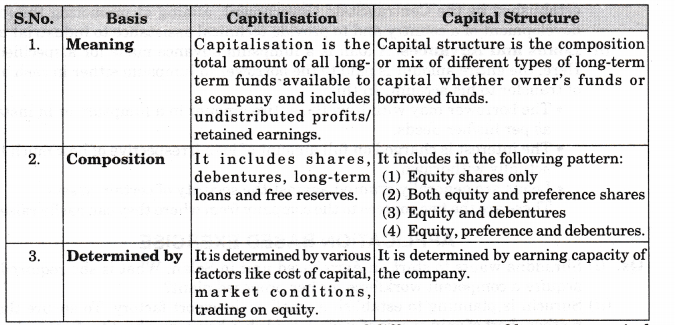
(iv) Capital structure is the composition or mix of different types of long-term capita whether owned or borrowed. It includes all the long term funds consisting of share capital, debentures, bonds, loans and reserves.
![]()
To find out an ideal debt-equity mix is a difficult task. Every entrepreneur should try developing that relationship of debt and equity securities which is maximum the value of a company’s shares in the market. There are many factors which are to be considered while designing an appropriate capital structure of a company like earning capacity of the company. The relative weightage assigned to each of these factors will vary widely from company to company depending upon the:
(а) Characteristics of the company
(b) General economic conditions prevailing
(c) Circumstances under which the company is operating.
A proper proportion between fixed and variable yield-bearing securities is very necessary for the liquidity and solvency of the company.
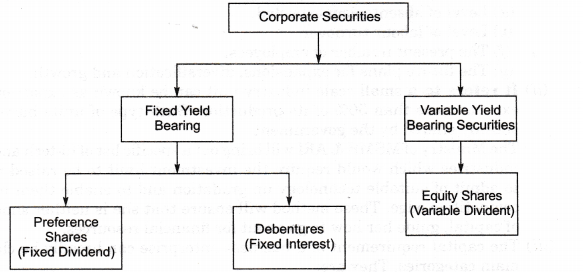
If a company make an ideal capital structure which shows a high degree of earning capacity it shows a result of great, planning and team work.
(v) (i) Loans from Financial Institutions: Institutional finance refers to institutional sources of finance to industry, other than commercial banks. These institutions are established by the Central/State Government, aiming at promoting the industrial development of a country and to provide technical assistance to industrial units.
(ii) Loans and Advances: A loan is a lumpsum advance made for a specified period. Here, the entire amount is paid to the borrower in lumpsum either in cash or by way of transfer to his account. In this:
- The borrower may withdraw the entire amount in a lumpsum or in installments as per his/her needs.
- The interest is charged on full amount of loan irrespective of how much had been actually withdrawn.
- Loans are generally granted against the security of certain assets.
These are the two sources to the company from where they can easily raise finance.
Application Based Exercise
Question. (i) Shraddha wants to start an Agro-based unit in Solan. What is she required to do to acquire a competent workforce for her proposed plant?
(ii) Suruchi is planning to establish a small scale export factory. To ensure that she is neither short of or in excess of capital, guide her how to go about for financial resources.
(iii) Mr. Nair, while planning for the financial requirement, overlooked the use of Technology in Production. What loss can befall on society because of his act of ignorance.
(iv) Mukesh is planning to establish a restaurant at Connaught Place, Delhi. What patterns of capital structure are available to him? Give reasons.
(v) Shalini plans to set up a Printing Press in Ludhiana. She looks upto her cousin Amit, who is successfully running a similar unit in Jaipur, for all possible help, guidance and suggestions. What kind of mentoring is this?
(vi) Malti, wants to commence a Blue Pottery Enterprise. Before starting, multiple information is required as a part of her systematic planning. Discuss the methods available to her to collect the required data.
Answer: (i) People required for various positions throughout the enterprise gets affected by:
(a) Finding out the total amount of works to be done and then dividing it into different sets of activities.
(b) The total number of tasks and jobs required to be accomplished under different activities.
(c) How much work can the average person do in a specified period of time?
(d) Level of absenteeism expected.
(e) Level of labour turnover.
(f) The present number of employees.
(g) The future plans for expansions, diversification and growth.
(ii) It refers to a small scale industry unit can be known as export-oriented unit if it exports more than 50% of its production. Such type of units have the benefit like subsidy offered by the government.
The Ministry of MSME & ARI will bring out a specific list of hi-tech and export oriented industries which would require the investment limit to be raised upto Rs. 5 crores to admit of suitable technology up gradation and to enable them to maintain their competitive edge. These method will ensure that she is neither short of or in excess of capital, guide her how to go about for financial resources.
(iii) The capital requirement of a business enterprise can broadly be classified into two main categories. They are:
(i) Fixed capital requirements (ii) Working capital requirements.
In general the technology to be used in production can be of two types
1. Capital-intensive Technique: It refers to more amount of capital required to start a business like machineries.
2. The labour-intensive technique refers to more number of labour to start the business. While planning for the financial planning technology in production to be used is one of the important decision taken by an entrepreneur and the financial requirements depends on a number of factors, the most important being the size of the enterprise, the industry group in which it operates and the nature of the technology employed. In general, small enterprises tend to have lower relative requirements for fixed as against working capital because of the high degree of labour intensity and if it a large scale industries the fixed capital requirement. Requirement is more as compared to working capital requirement as more investment in fixed assets. The fixed capital requirement should be correctly assessed and financed carefully for the smooth running of enterprise.
(iv) Capital structure is the composition or mix of different types of long-term capital whether owned or borrowed. It includes all the long term funds consisting of share capital, debentures, bonds, loans and reserves.
The patterns of financing, i.e. deciding about the types of securities to be issued for raising the necessary funds is what capital structure determines.
Patterns of capital structure are available to him.
In case of a new company, the capital structure may be of any of the following patterns:
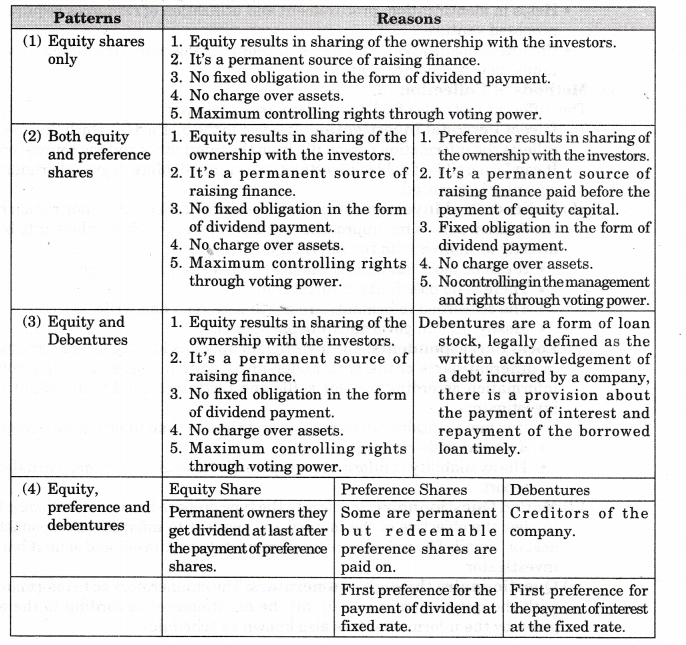
( v ) It is a type of informal mentoring—Peer mentoring.
Informal mentoring is a voluntary relationship. In this the satisfaction and personal rewards a mentor gains from an effective mentoring relationship. They are free to withdraw from it if it becomes unproductive or onerous. The mentored individual can, therefore, enjoy the advantages of the mentor relationship without guilt. The starting point is to be very clear on how a mentor could help you at this point in your career. What specifically do you need? This will be personal to your circumstances but might include one or more of the following:
As he assist in her for preparation of documentation and other help
• Personal-a mentor provides both professional and personal support
• Career direction/guidance
• How to handle office politics?
• Options for skills development
• Professional/technical help
• Support through a decision-making process
• Organisational information/knowledge
• Help a mentee to assess his/her areas of shortcomings and strengths, giving critical feedback to him in key areas
• Helps in identification, procurement and utilization of resources required for the proposed venture
• Provides consultation, and helps in coordinating activities aimed at accessing funds, new technologies, etc.
(vi) Methods of Collection:
The different methods of collecting data are as follows:
(а) Direct Personal Investigation: It refers to the method by which the investigator collects the information personally from the informants and the source concerned. It can be possible if field of investigation is limited. More degree of originality and accuracy is required.
(b) Indirect Oral Investigation: The investigator collects the information not from the original person but approaches certain sources which are close or to be known directly or indirectly to the informants.
• It can be more suitable, if the field of investigation is large.
• There is no possibility of direct contact.
• The concerned informants are not able to read and write.
• Mostly used in government departments.
(c) Local Correspondents: The investigator appoints local agents or correspondents in different parts of the area under investigation. Generally, they collect the information according to their skills and tactfulness and then submit it to the investigators.
• It is more suitable when regular and time to time information is required.
• Area has wide coverage.
• The availability of information is possible through magazine, journals, annual
report.
(d) Mailed Questionnaire: It refers to the type prepared by the investigator keeping in view the objective of the inquiry and sends it to informants/respondents who post or e-mail. The informants fill it completely by himself and send it back to the investigator.
(e) Questionnaire through enumerators: The enumerators go to informants along with the questionnaire to help fill the questionnaire according to the answers given by the informants. It is also known as schedules.
MORE QUESTIONS SOLVED
I. Very Short Answer Type Questions [1 Mark]
Question 1. Name the word ‘mentor’ comes from.
Answer: The word mentor comes from the character “Mentor” in Homer’s epic tale, The Odyssey.
Question 2. What do you understand by mentorship?
Answer: Mentorship is a developmental partnership through which one person shares knowledge, skills, information and perspective to foster the personal and professional growth of someone else.
Question 3. Why mentor is also called as trusted guide?
Answer: Mentor is also called as trusted guide because he is a wise advisor, creates an informal environment, in which the other person feels encouraged to discuss their needs and circumstances openly and with confidence.
Question 4. What do you understand by captive unit arrangements?
Answer: Captive Service is a portion of Business Process Outsourcing where an organization will use a wholly owned subsidiary instead of a Third Party Vendor. Parent company will use the resources made by the subsidiary company , with the only benefit of reducing the cost of production, cost of saving of using outside resources and easily maintaining and complete control over the process.
Question 5. What do you mean business etymology of “business”?
Answer: The etymology of “business” relates to the state of being busy either as an in dividual or society as a whole doing commercially viable and profitable work.
Question 6. How L.H. Haney has defined the term ‘ Business’?
Answer: “Business may be defined as a human activity directed towards producing or acquiring wealth through buying and selling of goods”. L.H. Haney
Question 7. Define strategy.
Answer: ’’Strategy is the direction and scope of an organisation over the long-term; which achieves advantage for the organisation through its configuration of resources within a challenging environment, to meet the needs of markets and to fulfil stakeholder expectations”. —Johnson and Scholes
Question 8. How will an entrepreneur can classify business activities?
Answer: Business activities can be also classified on the following grounds/basis:
(i) activity (ii) size (iii) ownership.
Question 9. Neerja wants to start a small size business in her colony. Give some examples of tiny units she can approach for.
Answer: Stationery shop, schools, parlours, photostate and STD booths in your locality.
Question 10. Who is called as a brain box of the enterprise?
Answer: Managerial staff is called as a brain box of the enterprise.
Question 11. Why some entrepreneurs outsource professional experts?
Answer: Professional experts can be outsourced by the entrepreneur because the small enterprises cannot afford them on their regular payrolls.
Question 12. Give examples of professional experts who render their services to run the business enterprises.
Answer: Chartered accountants, auditors, bankers, lawyers, are important professional experts who render their services to run the business enterprises.
Question 13. What features are to be considered for adopting the technology by an enterprise?
Answer: The technology should he latest, valid, credible, and must have proper and have sound technical values.
Question 14. What do you mean by the term licentiates?
Answer: Licentiates refers to any individuals holding professionals licenses, or it indicates that any person who holds a certificate of competence to practice a profession. They may run to partnership, firms, or corporations as well as to individuals.
Question 15. If an entrepreneur cannot personally supply the necessary amount of money he can go for another option, i.e. (OPM) .What does this OPM stands for?
Answer: OPM stands for ‘OTHER PEOPLE’S MONET.
Question 16. How an entrepreneur workout financial resourcing for a business?
Answer: (1) How much finance is required?
(2) The terms for which finance is required.
(3) What are the sources of generating finance?
Question 17. What constitutes borrowed capital?
Answer: The capital, which is borrowed by the entrepreneur from banks, financial organizations, or from any other source constitutes borrowed capital.
Question 18. What do you understand by intangible resources?
Answer: These resources are neither be touched or can be seen but that have value but helps immensely in providing a strong foothold to enterprise.
The intangible possession is a resource which enables a business to continue to earn a profit that is in excess of the normal basic rate of profit earned by other business of similar type.
Question 19. Enumerate the categories of intangible resources.
Answer: This category generally comprises:
(i) Goodwill (ii) Reputation
(iii) Brands (iv) Intellectual Property.
Question 20. What do you mean by goodwill?
Answer: Goodwill = acquisition price – net assets.
Question 21. What do you mean by reputation?
Answer: It is business tactics which could help gather the necessary support from employees and suppliers to get good name in the market.
Question 22. What do you mean by Intellectual Property?
Answer: The steps in the process of financial planning are as follows:
Question 23. Define financial planning.
Answer: Financial planning is deciding in advance how much to spend, on what to spend on the basis of availability of funds.
Question 24. How strong brands help an entrepreneur as a key factor?
Answer: Strong brands are often the key factors to know in whether a growth strategy is a success or failure and it will help an entrepreneur to command and sustain with higher margin.
Question 25. Define financial planning.
Answer: Financial planning is deciding in advance how much to spend, on what to spend on the basis of availability of funds.
Question 26. What do you understand by manning table?
Answer: A manning table is a listing of the positions or number of workers to be used in the operation of a particular machine or process.
Question 27. What is the basis of obtaining unsecured loans?
Answer: Unsecured loans are mostly given on the credit worthiness and capacity to pay of an entrepreneur.
Question 28. Why is finance called as a master key?
Answer: Finance is also known as the master key because it provides access to all the other sources for being employed in manufacturing, trading and services activities.
Question 29. What do you mean by the manning table?
Answer: It refers to a listing of the position of workers number of employees to be used from top level to lower level in the manufacturing process or of a particular machine or for a particular job.
Question 30. Define the term ‘Job’.
Answer: ‘Job’ is a task or piece of work especially one that is paid.
II. Short Answer Type Questions [2/3 Marks]
Question 1. What are the steps in the process of financial planning?
Answer: The steps in the process of financial planning are as follows:
(a) Estimation: Amount of funds or capital to be required in the future is estimated.
Here, the amount of money to be raised bases on goals is determined.
(b) Determining securities: For acquiring capital what securities are to be issued is determined here. The form, types, size, etc. of the securities is to be fund to be raised,
(c) Formulation of policies: After estimating the requirement and determining securities, the next is formulating policies for administrating the capital. This involves the making of various targets, ensuring proper utilization of funds, etc.
Question 2. Define Finance.
Answer: Finance may be defined as the provision of money at the time as per the requirement.
Question 3. How an entrepreneur sources to procure finance for small business?
Answer: Finance is required whether the business is small or large. Sources of procurement of finance for small business : Own saving or raise loans from relatives, friends or some financial institutions.
Question 4. Define Business Finance.
Answer: Business Finance may be defined as the acquisition and utilization of capital funds in meeting the financial needs and overall objectives of a business enterprise.
Question 5. “Business Finance is an activity”. Comment.
Answer: Business finance is that activity because it is concerned with the planning, fund raising, controlling and administering and managing of all the funds to be used in the business enterprises whether business is small or large.
Enumerate two major of financial decision-making by an entrepreneur.
The two major areas of financial decision-making, requires on part of entrepreneur to take the:
(a) Funds requirement decision: It is concerned with the estimation of total funds required to start and run the business enterprise.
(b) Financing decisions: It is concerned with the sources from which the funds are to be raised.
Question 6. Difference between seed capital and margin money.
Answer:
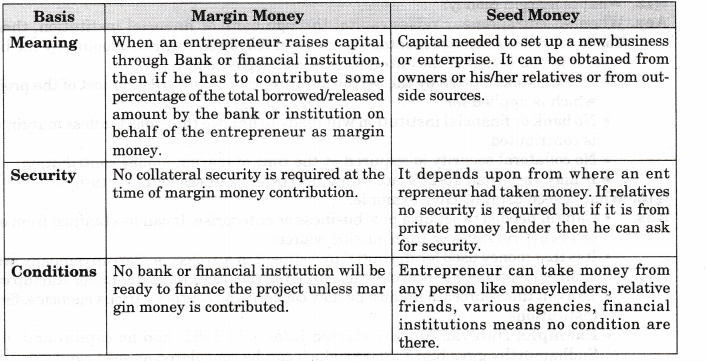
Question 7. What do you mean by over-capitalisation?
Answer: Overcapitalisation signifies a situation when an enterprise possesses excess of assets in relation to its actual requirements.
Overcapitalization always indicates that actual earning is always lesser than the decided one.
Question 8. What do you mean by under-capitalisation?
Answer: It refers to a situation when actual capitalisation is lower than the proper capitalisation. Under-capitalisation capital always shows the assets value may be more than the values reflected in the books of accounts.
Question 9. How need of financial resources helps an entrepreneur?
Answer:
- Finance is one of the important prerequisites to start an enterprise.
- It helps an entrepreneur to arrange all other required resources together like, personnel, machines, materials, methods, land, etc. to startup the business systematically.
- It helps an entrepreneur to start his business activities smoothly and convert a dream into reality.
Question 10. What do you understand by owner’s funds? Enumerate the forms of owner’s funds.
Answer: Owners fund is a type of finance for an enterprise. It is that part of total investment that belongs entirely to the entrepreneur of the business.
- This fund can be provided by a single owner or by a group of owners.
- In such funds the risk is to bared by the owner himself.
- More is the proportion of owner’s fund in the enterprise, higher control is enjoyed by the entrepreneur.
Owner’s funds can be in the form of:
(a) Equity capital (b) Preference capital (c) Margin money/Seed money
Question 11. What is short term capital?
Answer:
- The amount of capital which is invested in the enterprise for a period less than one year.
- Such capital is needed for fulfilling the day to day requirements of the enterprise. It is needed for procuring raw material, finished goods, spare parts, advertising, marketing etc.
- Such capital is obtained from financial institutions against the securities. It is needed more by the enterprises having longer length of operating cycle.
Question 12. What is margin money?
Answer: When an entrepreneur raises capital through bank or financial institution, then if he has to contribute some percentage of the total borrowed/released amount by the bank or institution on behalf of the entrepreneur as margin money.
- It is the contribution by the borrower/entrepreneur towards the cost of the project for „ which is applied for.
- No bank or financial institution will ready to finance the project unless margin money is contributed.
- No collateral security is required at the time of margin money contribution.
- It may vary from 15-25% according to type of business and institution.
Question 13. What is seed capital? Give example.
Answer:
- Capital needed to set up a new business or enterprise. It can be obtained from owners or his/her relatives or from outside sources.
- It is that money used for the initial investment in a project or startup company provided to an entrepreneur to prove the feasibility of the project and quality of startup capital.
- To avail this sources of finance he may concern and contact various agencies, financial institutions.
- Example: Narayan Murthy started Infosys in 1981, had no capital and his wife Sudhamurthy gave him Rs 10,000 which can be considered as seed capital.
Question 14. State any three important aspects which is mandatory for an entrepreneur regarding the proper planning and disbursement of funds:
Answer:
- The total amount of finance required for implementing the business plans (how much money is needed)?
- The forms and proportion of various securities to be used for collecting the desired amount, such as, where the money will come from.
- The policies of utilization and administration of capital, (how can the firm utilize these funds in the best possible manner)?
Question 15. What do you understand by finance?
Answer: The entrepreneur at every point of time needs money and he makes the arrangement of money whenever it is needed.
More is the size of enterprise more is the requirement of finance and it is used for purchasing raw materials, tools, equipments, hiring services, etc. thus we can say- finance means the arrangement of money at the time it is required is finance.
Question 16. “Sound financial planning is necessary for the success of any business enterprise”. Explain
Answer: Yes, I agree with the statement. It entails.policies and procedures for proper coordination between the various functional areas of business, involving proper allocation of resources amongst the various departments.
Question 17. How a business enterprise gets affected without an accurate financial plan?
Answer: Any enterprise/entrepreneur will start his business with an accurate plan embodying the financial needs of the company in the present and future. It is definite that the enterprise may have to face frequent difficulties and obstacles which may hamper the growth of an enterprise.
Question 18. What does a mentor do?
Answer: As a teacher he teaches the mentee about a specific issue.
As a coach coaches the mentee on a particular skill.
As a facilator he facilitates the mentee growth by sharing resources and networks.
As a challenger he challenges the mentee to move beyond his or her comfort zone.
And he always creates a safe learning environment for taking risks and focuses on the mentees total development.
Question 19. What do you understand by ‘Silo Mentality’?
Answer: It is a situation in some organisation/business firms where few people work in a different mindset. In these the employees in the same organisation or departments employees do not wish to share information/knowledge with other individuals or other departments. It is also called as a attitude problem of an enterprise.
Question 20. What do you understand by the term business?
Answer: An economic activity which is conducted on regular basis to earn profit through the sale, exchange or transfer of goods and services, is referred as business.

Question 21. How can mentoring be classified on two grounds?
Answer: Mentoring thus may be classified on two grounds:
(a) Mode of construction (in which way mentorship is structured)
(b) Mode of delivering (in which manner mentorship is rendered)
Question 22. How to overcome ‘Silo Mentality’ in an organisation?
Answer:
- Giving new employees good atmosphere, and proper orientation and make them to understanding of all departments, encourage them to work in team.
- Regularly good communication and check with all the activities in the organisation and briefing the employees.
- Time to time taking good decision and careful regarding the selection and proper training of employees.
All these techniques will help an organisation and team leader to achieve the organisational goals and objectives.
Question 23. Different firms need different resources. Enumerate the requirement of resources depends upon.
Answer: Different firms need different resources. The requirement of resources depends upon:
(a) Nature of activity (b) Size of activity
(c) Product specification (d) Type of business activity.
III. Short Answer Type Questions [4 Marks]
Question 1. What are the features of borrowed capital?
Answer: Borrowed capital is the capital borrowed by the enterprise for the normal running of the enterprise. Its features are:
- Interest: The borrowed capital has to be repaid with interest.
- Time period: The borrowed capital is to be paid back in the agreed time limit. Thus, it is the obligation of the entrepreneur.
- Right of control: The lenders of borrowed capital normally have no control over the management of the enterprise. However, some conditions are to be fulfilled by the entrepreneur.
Question 2. Mention the various sources of raising short term capital.
Answer: Trade credit, cash credit, bank overdraft, discounting bill of exchange, etc. some sources of raising short term capital.
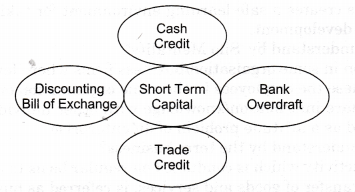
Question 3. What is medium term capital?
Answer: The amount of capital which is invested by the entrepreneur from a period more than one year but less than five years is medium-term capital. Such capital can be raised through debentures; loans from financial institutions, preference shares, etc. and it can be used for development, extension, expansion, and modernization, etc. of the enterprise. It may or may not form a part of working capital. Normally it is not used as working capital.
Question 4. What is meant by long term capital? Why is it needed?
Answer: The amount of capital which is invested in the enterprise for a period more than five years but less than 25 years is a long term capital. It is needed for the following:
(a) For acquiring fixed assets like building, machines, etc.
(b) For development of enterprise.
(c) For research related with product.
Question 5. What is collateral security?
Answer: It refers to a security of fixed assets given by an entrepreneur to banks and financial institutions against a sum borrowed by him. The assets mortgaged with the institution for the sanction of a loan. Except certain government schemes, banks and financial institutions require physical (asset) security to release loans. Fixed assets like buildings, land, machinery, etc. Registered in the name of entrepreneur can be used as security to release loans.
Question 6. How the ‘Silo Mentality’ in workplace affect the enterprises culture?
Answer: A silo mentality is an attitude found in some organisations that occurs when several departments or groups do not want to share information or knowledge with other individuals in the same company.
Increasing effect of Silo Mentality always :
- Reduces efficiency of overall business enterprise.
- It leads to poor communication, reduced trust, and often keeps one department or group against another.
- This leads to cost overruns, project delays, wasted efforts, poor products falling production and falling sales and ultimately less profit.
- It gives a bad reputation of an organisation in the market.
- It reduces morale among the employees.
Question 7. What happen if an entrepreneur run his enterprise with outdated, obsolete, worn-out machinery or stick into sick plants?
Answer: If an entrepreneur runs his enterprise with outdated, obsolete, worn-out machinery or stick into sick units then it will result in bad capital budgeting decisions but also hamper the innovation and creativity of an entrepreneur.
Question 8. What are the abilities a successful entrepreneur should possess?
Answer: The success of any enterprise lies in the capacity and ability of the entrepreneur to:
(i) Mobilize the resources
(ii) Organize the resources
(iii) Manage them efficiently and effectively as they are always scarce with reference to their demand.
Question 9. What three important decisions are to be taken by an entrepreneur for efficient utilization of human resources?
Answer: Thus efficient utilization of human resources is only possible if the entrepreneur is able to decide:
(i) The total work to be done
(ii) The right type of people who can do the work.
(iii) Employing right man at right job.
Question 10. Why an entrepreneur realized that there is a need of Expert Professional Assistance to an enterprise for more efficiencies in their operation and can easily reduce the cost in effectiveness?
Answer:
- Need of expert Professional Assistance in an enterprise for more efficiency in their day-to-day activities and can easily improve the cost effectiveness.
- Entrepreneur realizes that he can’t be an expert in all the areas and cannot do proper justice in all the areas of an enterprise.
- Individually no entrepreneur can utilize properly all resources, time and energy to meet their day-to-day requirements of the enterprise.
Thus, either outsourcing or availing of professional services from outside the firm, has become a major trend in human resources over the past decade.
Question 11. Enumerate the various methods by which an entrepreneur can arrange various types of resources.
Answer: It is for the entrepreneur to analyse and evaluate the extent, nature and type of resource required. Commonly, one can arrange for these through:
- Contractual arrangements
- Third party arrangements
- Lease basis
- Captive unit arrangement
- Part time arrangement
- Regular basis.
Question 12. What is the difference between Term Loan and Demand Loan?
Answer: Difference Between term loan and demand loans.

Question 13. What do you understand by intangible resources?
Answer: An intangible asset is an asset that does not physically or materially exist: Though an individual may not be able to view or touch an intangible asset, it can still be extremely valuable. In most cases, it is the companies that possess intangible assets, such as business contracts.
Question 14. Distinguish between Formal mentoring and Informal mentoring.
Answer:
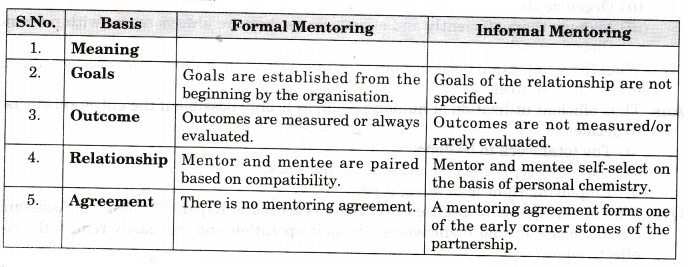
Question 15. “A mentorship relationship is based on trust.” Do you agree? Comment.

Answer: Yes, I agree with the statement. The relationship between mentor and mentee is totally based on trust.
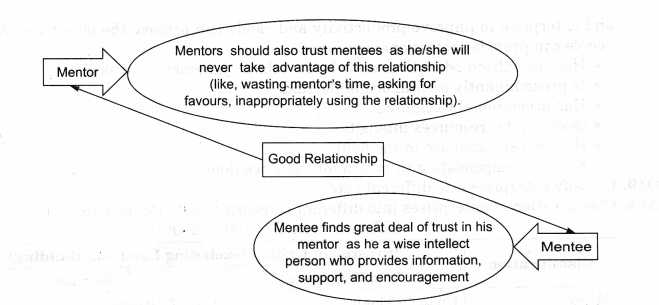
Building trust can take time; our behaviours can accelerate the time it takes.
Question 16. Draw a flow chart of types of mentoring.
Answer:
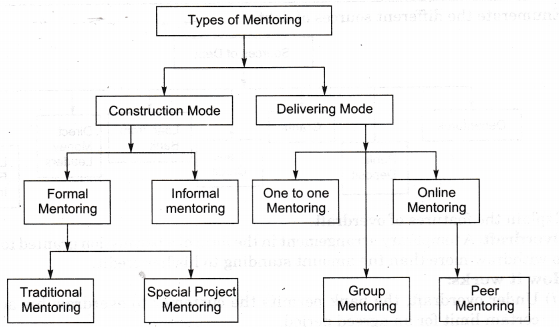
Question 17. Explain the features/characteristics of the term business.
Answer: Characteristics of the term business are the following:
(a) It is a day-to-day economic activity of the enterprise.
(b) It deals with exchange, sale, transfer of goods and/or services in the enterprises with
various types of people. .
(c) Exchange of goods, sale or transfer of goods and services can be cash basis or it can be credit basis.
(d) There is regularity in dealings means daily, weekly, monthly, quarterly, six monthly etc.
(e) The main motive of every business dealings are with profit motive.
(f) Every business has an element of risk.
(g) Business deals with creation of utility.
(h) To be business the activity should be capable of consumer satisfaction.
Question 18. What are professional services?
Answer: Professional services support entrepreneurs and enterprises of all types whether small scale industries or large scale industries in the economy. The provided services includes . legal advice, tax advice, financial advice and business advice. It helps an entrepreneur and enterprise to improve productivity and easily can achieve the objectives. All those
people can provide professional services:
• Has specialized education, knowledge, labour, judgment and skill.
• Is predominantly mental or intellectual.
• Has professional workforce.
• Good capital resources intensity.
• Has proven expertise in the field.
• Expects compensation in return for the work done.
Question 19. Classify enterprise into different categories.
Answer: Classification of enterprises into different categories (New Definitions)

Question 20. Enumerate the different sources of debt.
Answer:

Question 21. Explain the features of overdraft.
Answer: Overdraft: A temporary arrangement in the form of a permission granted to the customers to withdraw more than the amount standing to his/her credit.
How it works:
(i) Under overdraft, the bank permits the customer to overdraw his account up to a
certain limit for an agreed period. .
(ii) To avail of this facility, a customer should have a current account with that bank.
(iii) Interest is charged on the amount actually overdrawn.
(iv) Overdraft may be allowed on the security of assets or customer’s personal security.
Question 22. What do you mean by business cycle? Draw diagram.
Answer: The term business cycle refers to economy-wide fluctuations in production, trade and economic activity in general over several months or years in an economy organized on free-enterprise.
Principles: It is also known as economic cycle or boom-bust cycle.
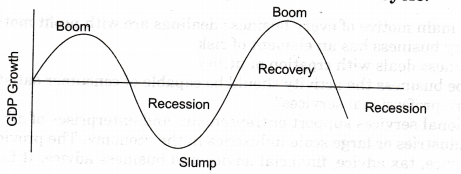
Question 23. Name:
(а) The activities connected with the production are called as.
(b) The activities connected with the distribution of goods produced from the factories to the consumers are called.
(c) Name the better way of classifying business activities.
(d) Industrial unit whose investment in plant and machinery does not exceed ? 5 crores.
(e) During inflation, an entrepreneur need more working capital or less working capital.
(f) Name the type of credit in which credit period of 180 days is extended on purchase of
supplies.
Answer: (a) Industry
(b) Commerce.
(c) A better way of classifying business is size-wise.
(d) Small scale industries.
(e) More working capital.
(f) Trade credit.
Question 24. Categorise the types of Small Scale Industrial Unit with their investment capacity and limits.
Answer:

Question 25.Differentiate between cottage industries and rural industries
Answer:
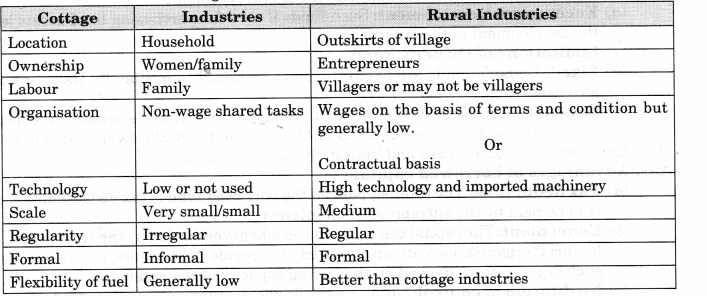
Question 26.Distinguish between shares and debentures.
Answer:


Question 27.What do you understand by physical resources? Availability of resources determines the location of an enterprise. Do you agree? Justify of your answer?
Answer: Yes, it is true that availability of resources determine the location of an enterprise. It is because of following reasons:
(a) Cost factors: If sources of resources are near the enterprise then the transportation cost is reduced.
(b) Supply factors: The supply of resources is quick if resources are readily available.
(c) Maintenance: The maintenance of machinery becomes easy as vendors are readily available.
IV. Long Answer Type Questions [6 Marks]
Question 1. What are the advantages and limitations of owner’s funds?
Answer: Advantages of owner’s funds
(a) Control: More is the owner’s fund in the enterprise, higher is the control of the owner. Thus, it increases the control of entrepreneur.
(b) Risk: More is the owner’s fund, more is the limit of risk. This is because such funds do not increase the obligations of the enterprise.
(c) Decreases Obligations: Higher is the owner’s funds in the over all capital of the enterprise, lesser is the obligations of the entrepreneur.
(d) Encourages Development: Such funds if used for purchasing fixed assets leads to the development of the enterprise.
Limitations of Owner’s Fund
(a) Fixed: Owner’s funds are fixed. It cannot be raised immediately. Its accumulation also needs time.
(b) Depends on savings of the owners: Savings of the owners depends on the income of the owner. Income in turn depends on the profitability of the owners fund is also low.
Question 2. Enumerate the advantages and limitations of borrowed capital.
Answer: Advantages of borrowed capital:
(a) Tax deductible: The interest paid on the borrowed fund is tax deductible, i.e. no tax is to be paid by the entrepreneur on interest.
(b) Convenient: The capital can be borrowed whenever needed by the enterprises. Many financial organisations are always ready to provide it. However, the amount lend by such organisations depend on the paying capacity of the enterprise.
(c) No dilution of control: Normally the financial organisations do not interfere in the matter of the enterprise. The entrepreneur is free to work even after borrowing.
(d) Reputation can be encased: Higher is the reputation of the enterprise in the society; higher are the chances of obtaining capital easily. Thus, the brand name of the enterprise can be utilized.
Limitations of borrowed capital:
(a) Fixed period: This capital is obtained for an agreed period of time. Also the interest and the principal amount are to be paid back in a given period of time.
(b) Increases obligations: The borrowed capital increases the obligation of the enterprise as the interest is to be paid periodically.
(c) Depends on security: Borrowed capital is obtained against security. Such securities if not available, then the enterprise is devoid of obtaining this capital.
Question 3. Enumerate the sources of long term capital.
Answer: Long term capital can be obtained through equity share, preference shares, debentures, as’loans from financial institutions, owner’s capital, undistributed profit of the enterprise, etc.
A form of secondary protection sometimes required by a bank and intended to guarantee a borrower’s performance on a debt obligation. The primary security on a substantial business loan is typically the thing that is being financed, such as a factory, company car or shipment, but secondary or collateral security might also be requested by a bank to help assure that the loan will be repaid.
Question 4. What is the difference between a secured and unsecured loan?
Answer:
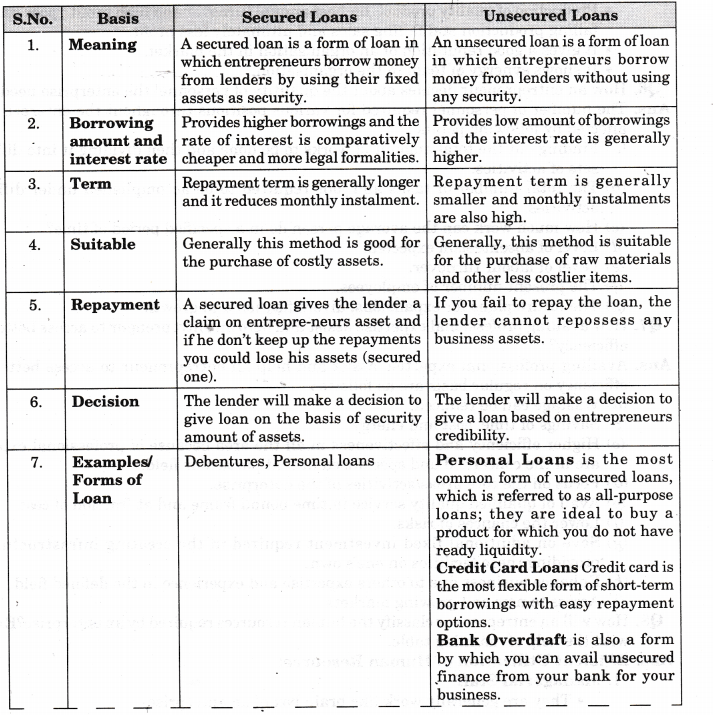

Question 5. How reducing silo mentality in workplace is always beneficial to a business firm?
Answer: It is a mindset of a group of people working in an organisation who do not wish to communicate and share their knowledge and information to other departments and colleagues.
Reducing silo mentality in workplace is always beneficial to a business firm as :
- It increases efficiency of overall business enterprise.
- It leads to good communication, increasing trust, and often keeps one department or group collaborated to each other.
- This leads to cost effectiveness, completion of project on time, full utilization of all resources and reduce wastage.
- Production of quality product, highest annual turnover and high profit., poor products falling production and falling sales and ultimately less profit.
- It gives a good reputation of an organisation in the market.
- It shows synergy of team in the organisation.
Question 6. How an entrepreneur decides about the quantity of personnel the enterprise needs?
Answer: The number of personnel required for various positions throughout the enterprise gets affected by following points :
(a) Finding out the total amount of works to be done and then dividing it into different sets of activities.
(b) The total number of tasks and jobs required to be accomplished under different activities.
(c) How much work can the average person do in a specified period of time?
(d) Level of absenteeism expected.
(e) Level of labour turnover.
(f) The present number of employees.
(g) The future plans for expansions, diversification and growth.
Question 7. How availing professional expertise assist and help an entrepreneur to access better cost efficiency?
Answer: Availing professional expertise assist and help an entrepreneur to access better cost efficiency on regular basis are as follows :
(a) Wastage can be reduced.
(b) Savings of time, cost and energy.
(c) Higher efficiency and effectiveness in all the area because of professional expertise are in the concerned and specialised in that particular field.
(d) Focus on the core areas/activities of the enterprise.
(e) Avail of qualified quality service in time bound frame and at fraction of cost.
(f) Lower the chances of risks.
(g) Save on additional fixed investment required in the creating infrastructure for ‘providing these facilities on one’s own.
(h) Enhance business due to others expertise and experience in the defined field.
(i) Access to new and growing markets.
Question 8. How will an entrepreneur classify the human resources required by an enterprise?Explain with the help of manning table.
Answer: Efficient Utilization of Human Resource:
1. Managerial Staff:
- They are generally work like brain box of an enterprise.
- They frame out policies, programmes, mission, vision objectives goals of an enterprise.
- They ensure their implementation and finally getting the work done from workers
is the field area of this category.
2. Non-managerial Staff:
- They are the real group of workers can be called as a backbone according to their skills and experience.
- They effectively converts the raw material into finished goods.
- Their nature of job, skills and experience decides the quality and quantity of workers to be assigned.
3. Trained Technical Manpower:
- They are technical experts.
- The main job assigned to them are:
- Selection of machinery, get training if required to operate the purchased machinery.
- Installation of machinery and maintenance of machinery.
- Continuous supervision and operation.
4. Administrative Manpower:
- These are the group of staff who provide support services to managerial, professional and trained staff to run the enterprise effectively the maintenance of the enterprise.
- They play an important role and connect all the staff members by providing and assisting services to them.
- They do not contribute to production directly but only provide assisting services.
5. Professional Manpower: Chartered accountants, auditors, bankers, lawyers, who are professional experts and they can be outsourced by the entrepreneur if required. Small enterprises cannot afford them on their regular payrolls.
Thus, efficient utilization of human resources is only possible if the entrepreneur is able to decide:
- The total work to be done.
- The right type of people who can do the work.
- Employing right man at right job.
Question 9. State whether the following require small or large working capital. Answer should be supported by a valid reason:
Answer:
